
Dominican Republic Safety 2024: Is Dominican Republic Safe to Visit?
In 2022, around eight and a half million tourists visited the Dominican Republic, making it the most visited country in the Caribbean, and the fifth most visited place in the Americas.
But is the Dominican Republic as safe as it is popular? The short answer to this question is both yes and no. This is because while travel advisories consider the country only moderately safe, you’ll likely have an incident-free vacation as long as you remain cautious. Now let’s get into some details regarding the safety conditions of this beautiful Caribbean country.
Is the Dominican Republic Safe?
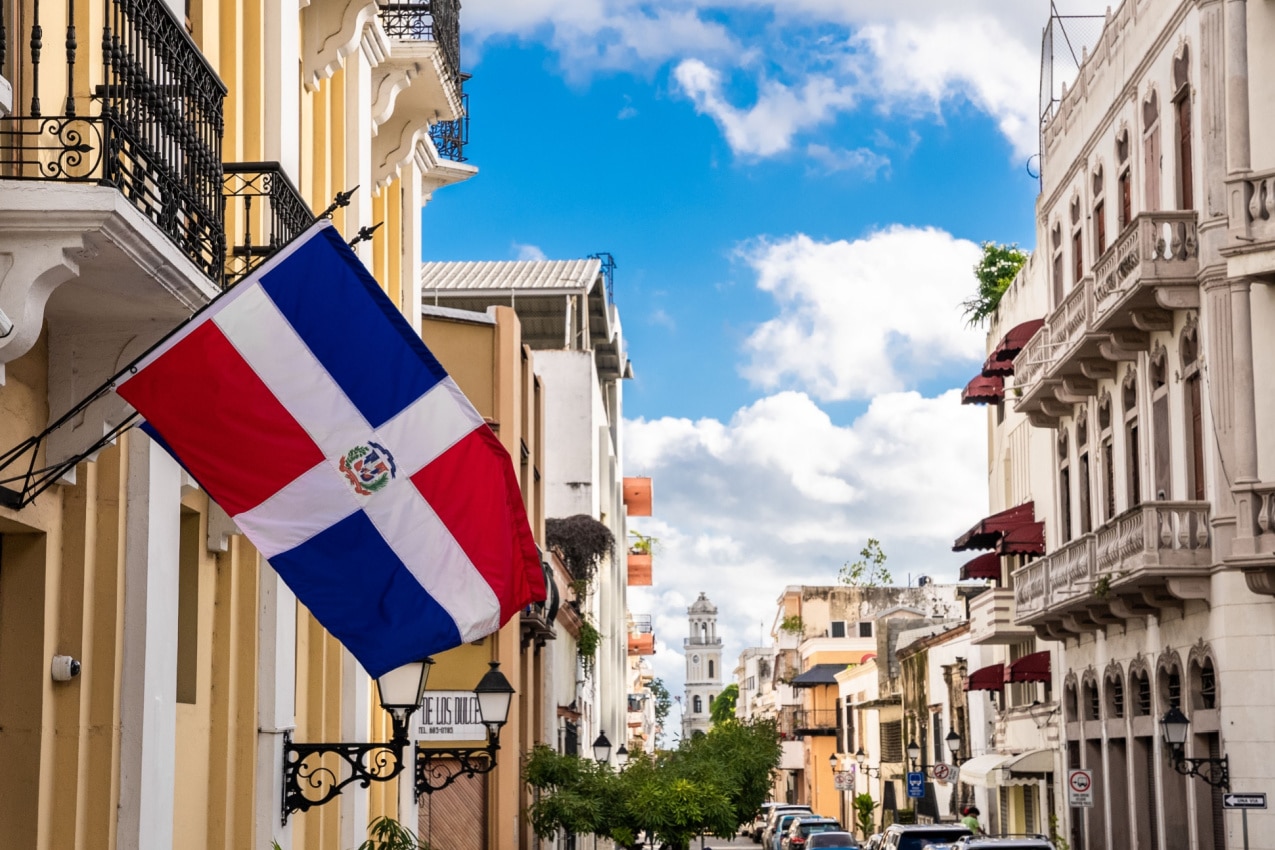
The UK travel advisory gives a well-balanced answer to this question:
“The Dominican Republic is friendly and welcoming and the vast majority of visits to the country are trouble-free. However, there is a high crime rate, ranging from opportunistic crime like bag snatching and pickpocketing to violent crime.”
Here’s a rough outlook of the country’s safety conditions:
- Travel advisory : All travel advisories consider the Dominican Republic a moderately safe location.
- Crime rate : Crime in the Dominican Republic is very high (71.34) — the main problem areas are theft, violent crime, scams, and the harassment of women.
- Dangerous areas : Stay away from La Duarte, Arroyo Hondo, Naco, Gazcue, Cristo Rey, Villa Agrícola, and Los Guandules.
- Police presence: There’s a special police force for tourists called politur .
- Natural Disasters : The Dominican Republic faces a moderate risk of hurricanes, earthquakes, and tsunamis.
- Public transport: The public buses are unsafe, but taxi companies are both safe and reliable.
- Medical care quality : It’s decent in the larger cities, but drops in quality as soon as you move toward the rural areas.
Travel Advisory for Dominican Republic
According to the US travel advisory, the Dominican Republic is classified in the level-2 safety category . That means you should exercise increased caution due to the high crime rate.
The US travel advisory ranks every country in four different categories, according to their safety level:
- Level 1: Exercise Normal Precautions
- Level 2: Exercise Increased Caution
- Level 3: Reconsider Travel
- Level 4: Do Not Travel
The other travel advisories, including the Canadian and the Australian ones, are on the same page. They cite the country’s high crime rate as the main cause for concern.
The most common crimes affecting tourists in the Dominican Republic are:
- Petty theft, including pickpocketing and bag snatching
- Assault and violent crime
- Scams and frauds
- Verbal harassment and abuse of women, including spiked food and drinks
A Comprehensive Look at Dominican Republic Crime Rates
Numbeo gives the Dominican Republic a crime rating of 71.34, which is considered a high crime index . Additionally, nearly all the individual categories for different types of crime are also either rated as very high, high, or moderate.
You can see the various scores in the table below. The data is shared by 361 contributors.
The Canadian travel advisory gives the best summary of the crime situation in the Dominican Republic: “Crime occurs in the Dominican Republic, including violent crime, especially in major cities. However, most incidents are opportunistic crimes which are the most significant threat for tourists.”
However, scams, frauds, and the harassment of women are also common.
Petty Theft
Petty theft happens all over the country, and it’s usually on the rise during the holiday season, when the country is packed with tourists. Petty theft is particularly frequent at:
- Bus stations
- Public transportation
- Airport terminals
Drive-by robberies and theft are also common in the Dominican Republic. Thieves on motorcycles or scooters drive beside unassuming tourists and snatch their bags or other belongings. They may even reach into a vehicle while waiting at a red light in traffic.
Violent Crime and Assaults
According to the Canadian travel advisory :
“ Violent crime against foreigners, including assault, occasionally occurs. Incidents take place mainly in large cities, at night or early morning. Some have been targeted in armed robberies when traveling to the Las Américas International Airport, sometimes in taxis.”
Most violent crimes are connected to organized crime rings and gangs , like the infamous Latin Kings. Gang-related violent crimes usually occur in poorer and more dangerous neighborhoods, but there have been cases of violent attacks affecting tourists, as well.
Anyhow, you should stay away from dangerous neighborhoods, since you’re much more likely to get attacked there. The most famous hotspots for crime in the country are:
- Arroyo Hondo
- Villa Agricola
- Los Guandules
Scam and Fraud
Scam and fraud are a constant threat in the Dominican Republic . Beware of:
- Criminals posing as policemen and fining tourists for made-up crimes.
- Rogue lawyers who operate near police stations and often target desperate tourists who have real problems.
- Credit card and ATM scams like cloning.
- Dating app scams and fraud that usually result in the victim getting isolated and robbed.
Verbal Harassment and Abuse of Women
According to the Australian travel advisory women are particularly at risk of harassment and assault.
The most common strategy of the perpetrators is spiking the food or drinks of victims with drugs. The drugs may be inside alcoholic or non-alcoholic drinks, snacks, chewing gum, or even cigarettes. Bars and other places of entertainment are their common territory.
Finally, dating apps also pose a danger. According to the US travel advisory :
“Several U.S. citizen travelers in the Dominican Republic have reported that they were robbed by people they met through popular online dating applications. If meeting with strangers, you should strongly consider meeting only in public places and avoiding isolated locations where crimes are most likely to occur.”
Police Presence in Dominican Republic
The Dominican Republic is protected by the Dominican National Police (Spanish: Policía Nacional Dominicana). They have nearly 32,000 officers for a population of almost nine million.
However, the Dominican police force isn’t considered to be reliable. Amongst other things, they are infamous for corruption and violent behavior , a hot topic in the media, particularly given suspicions that the police force is involved in illegal trafficking rings.
Luckily for visitors to the Dominican Republic, the country has an alternative police force that’s specifically created to protect tourists. That force is called Politur, and they’re scattered throughout the country, especially near tourist hotspots. You can easily recognize them by their uniform: white shirt and blue bermudas. They usually drive motorcycles.
Politur is highly regarded in the Dominican Republic and it’s a significant factor in maintaining its tourism industry. Recently , they received a $2 million boost and 65 new vehicles in the form of pickup trucks and motorcycles.
How to Stay Safe in the Dominican Republic
- If someone tries to rob you, hand over your personal belongings without resisting.
- Do not carry or wear valuable items that will attract attention.
- Contact the police or the hotel management if the resort or hotel staff demonstrate unwanted attention.
- Avoid secluded places, even at your resort/hotel.
- Don’t leave drinks or food unattended.
- Don’t use dating apps.
- Be careful around ATMs.
- Always ask police officers to legitimize themselves.
- Don’t use public buses.
- Stay away from dangerous areas.
- Avoid exploring the larger cities at night.
Is It Safe to Travel Solo in the Dominican Republic?
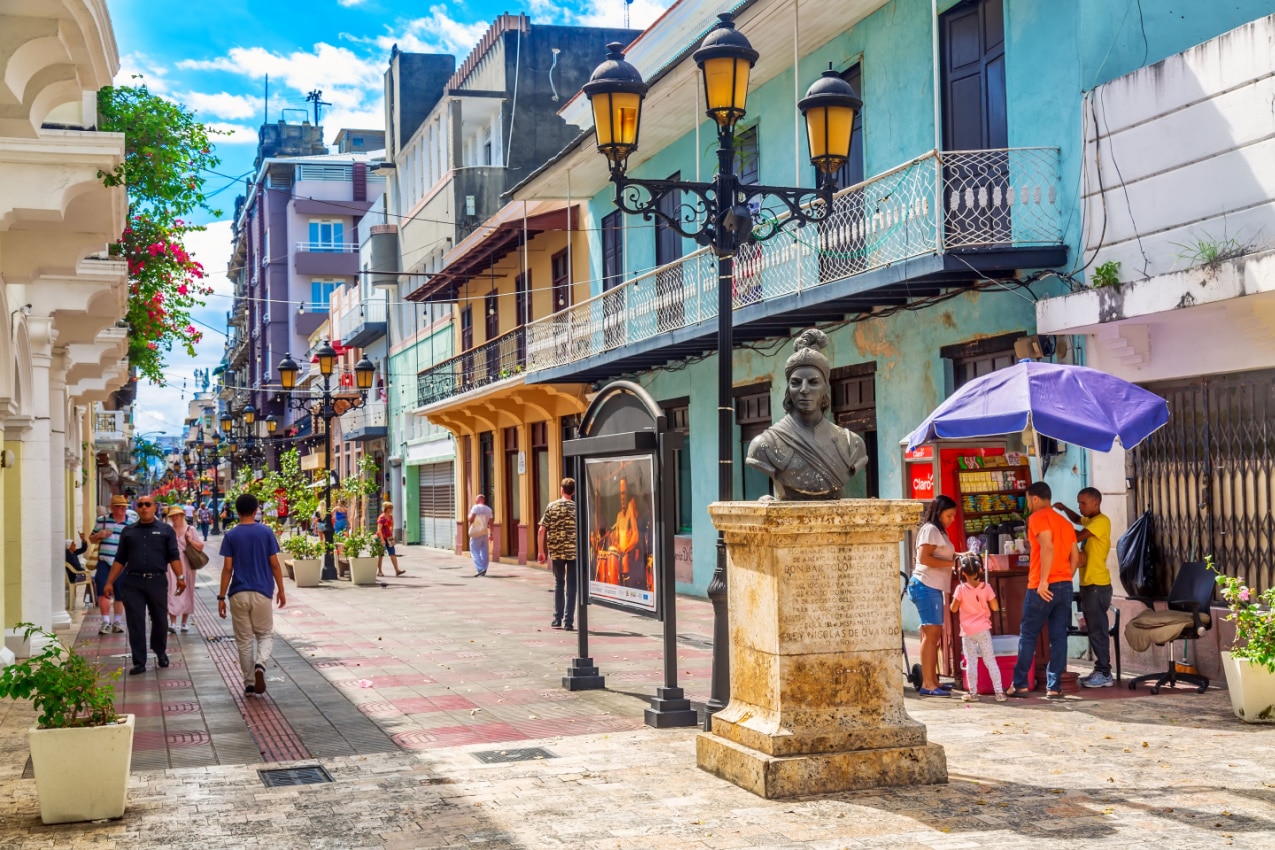
You can travel solo in the Dominican Republic if you’re well-informed and respect all the safety measures. That being said, it’s always better to travel with a group. Solo female travelers are particularly susceptible to all kinds of crime, particularly harassment and assault.
Is It Safe to Travel to the Dominican Republic as a Family?
Although it’s not the safest destination in the world, you and your family can visit the Dominican Republic as long as you are careful. This means that you should stay away from public buses, dangerous neighborhoods, and forlorn areas in the cities, and avoid going out at night. Sticking to some common sense tips can keep your mind at ease.
Perils of Nature: The Risk of Natural Disasters in the Dominican Republic
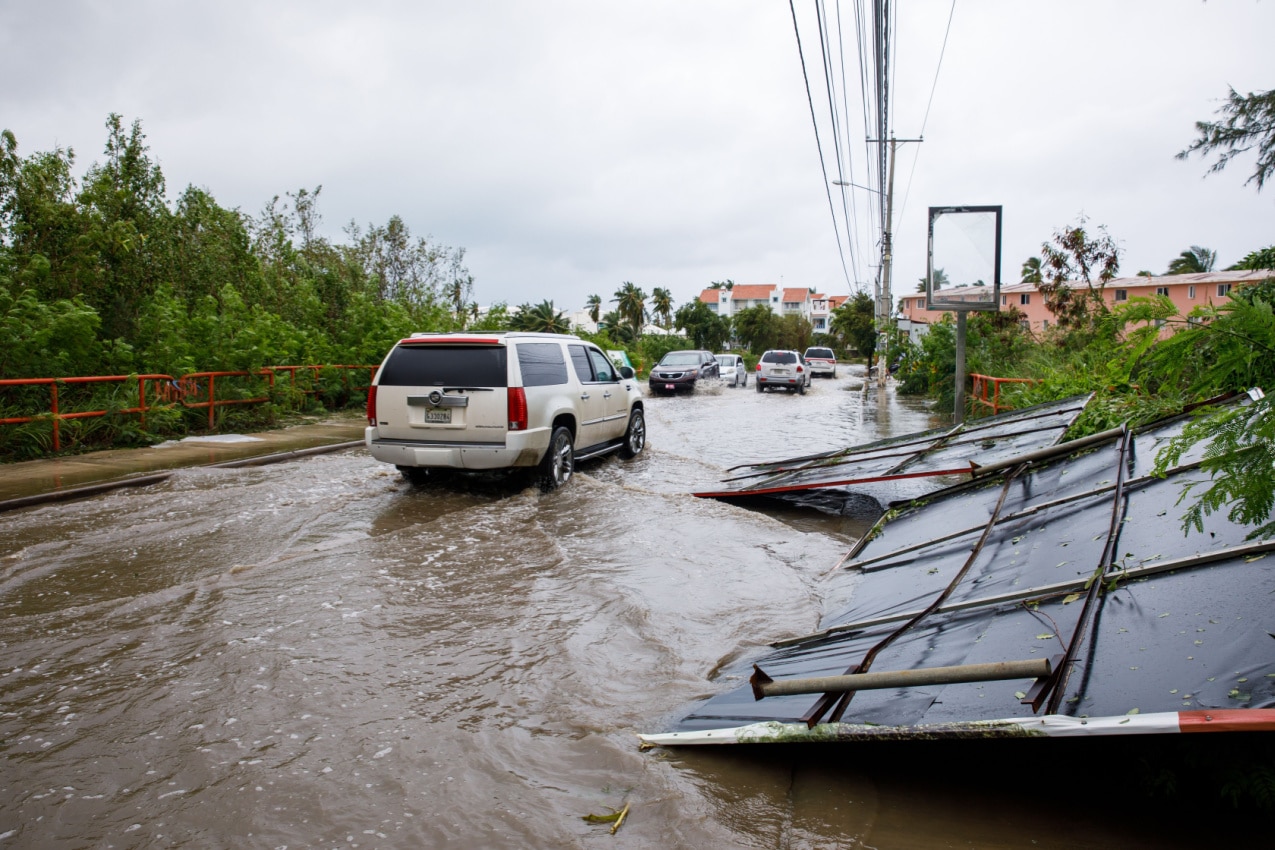
According to the Australian travel advisory , the Dominican Republic is subject to natural disasters and severe weather , such as:
- Landslides and mudslides
- Earthquakes
All of these can cause disruptions in the everyday lives of the local citizens as well as tourists’ vacations. More serious natural events can even disrupt essential services — such as water and electricity — or clog up the roads.
You have to stay cautious and prepared at all times, especially during the wet season, between May and November, when frequent rains are sure to cause landslides, mudslides, and flooding around the country.
Hurricane Information and Precautions
According to the US travel advisory , the Dominican Republic is hurricane-prone. The hurricane season begins in June and has its peak from mid-August to late October .
The coastal regions are at the highest risk of hurricanes.
On average, the Dominican Republic’s sphere of influence gets affected by at least six hurricanes annually , but only half of them directly hit the country itself.
The last hurricane to reach the country was “Franklin” on August 24, 2023 . While it was cruising on the open ocean, it was classified as a category-4 hurricane, but upon reaching the island, it lost its strength and resulted in a slightly more severe tropical storm.
The US travel advisory offers a comprehensive set of tips in case a hurricane hits the country:
- Maintain a stock of boiled or bottled water
- Store non-perishable food items
- Acquire a battery-powered radio
- Keep your vital documents (like your passport) safe and close to you
- Obtain travel insurance – it’ll certainly come in handy in the case of natural disasters
- Monitor all the local media, including the local radio and news reports
Also, it’s a good idea to follow the local and international sites that monitor hurricanes to stay up-to-date on the weather:
- Dominican National Office of Meteorology
- Dominican Emergency Operations Center
- National Hurricane Center
- Weather Channel
- Weather Underground
- Atlantic Tropical Weather Center
Earthquake and Tsunami Information and Precautions
According to the Australian travel advisory , the Dominican Republic is indeed in an earthquake-prone zone . This means that earthquakes could occur and cause destructive tsunamis. Some sources classify the earthquake hazard in the Dominican as “medium.” That means that there’s a 10% chance of a major earthquake hitting the country in the next 50 years.
On November 8, 2023 , a 5.0-magnitude earthquake affected the northwestern region of the country, near the border with Haiti. It was the strongest earthquake to hit the country that year. Fortunately, it didn’t cause any serious damage – except for two schools – or injure any people.
The UK travel advisory offers a pretty thorough procedure in case an earthquake occurs during your visit:
- Drop to the ground and take cover. Remain in this position until the tremors and the shaking stop.
- Don’t leave your position until it’s deemed completely safe.
- Stay away from street lights, buildings, and electric wires outside. Basically, avoid anything that can fall on you.
- Following the earthquake, don’t run and walk carefully. There may be aftershocks and debris.
- If you get trapped, tap on a wall or a pipe, so that rescuers can hear you.
As you probably know, stronger earthquakes may directly cause tsunamis. For example, in 1946 , an 8.1-magnitude earthquake struck the northern parts of the island and produced a very strong tsunami that resulted in over 1,000 fatalities.
Luckily, tsunamis are rare in the Dominican Republic and don’t accompany each earthquake. According to WorldData , there have only been 6 tidal waves that can be classified as tsunamis since 1751 – less than in other tsunami-prone areas.
Beware the Silent Threat: Carbon Monoxide Poisoning in Dominican Republic
The Dominican Republic is one of those rare countries where you should be wary of carbon monoxide poisoning.
According to the Washington Examiner , between 2016 and 2019, 14 people vacationing in the Dominican Republic were fatally poisoned by carbon monoxide.
It’s hard to get a figure of the total incidents resulting only from carbon monoxide poisoning. For example, a Louisiana woman lost her life in 2019: it was suspected to be carbon monoxide poisoning, but pesticide poisoning or even Legionnaire’s disease were not ruled out either.
Carbon monoxide is hard to notice since the gas is tasteless, odorless, and invisible. Longer exposure may lead to serious problems like paralysis and losing your life.
For peace of mind while staying in the Dominican Republic, your best bet is to buy a portable CO detector , which costs only around $20.
Dominican Republic Weather Patterns: What to Expect
The Dominican Republic has a tropical climate, and it’s mostly warm throughout the whole year. The period between May and October is wetter and hotter, while December to January is cooler and dryer. November and April are usually considered in-between months.
Monthly Average Temperatures and Rainy Days in Santo Domingo, Dominican Republic
Spring’s weather is sunny and dry. It’s one of the best periods to visit this country. The average temperatures never go below 68°F and higher than 89°F. Plus, there are very few rainy days per month.
Spring is the perfect time to visit the beautiful beaches of the Dominican Republic, such as Punta Cana, Bavaro, and Playa Dorada, but also to experience the excitement of the carnival in March, or the Santo Domingo de Fiesta and the Espiritu Santo Festival in May.
The beginning of summer signals the wet season in the Dominican Republic. The number of rainy days per month increases, and so do the temperatures, with a maximum daily temperature of 91°F. The weather can get stuffy and really hot, which is especially unpleasant for some.
And yet, the summer season is an undiscovered gem for many visitors who are looking for a budget trip to the island. Although the risk of a hurricane hitting the island is higher starting with August, the island is still perfectly safe during June and July.
With the coming of fall, the wet season reaches its peak. The temperatures are very high, and the number of rainy days per month is the highest in October (13 rainy days). The island is mostly tourist-free since it’s also the peak of the hurricane season.
That being said, it’s definitely the cheapest month to visit the Dominican Republic and the best time if you want to get to know the rites and customs of the local population. In September, you can experience the fantastic processions of la Dia de las Mercedes festival and the rural traditions of the Feria Ganadera El Cupey.
The tourist season begins in December. Beaches, resorts, and hotels start to fill up, and with the arrival of visitors, the prices start to rise. The temperatures start to drop after sunset, reaching 71°F, while the days are sunny, dry, and warm.
January is all about New Year celebrations, and the crowded islands brim with excitement and activity. February, on the other hand, is the official beginning of the carnival season, which attracts even more tourists.
Public Transportation Safety in Dominican Republic
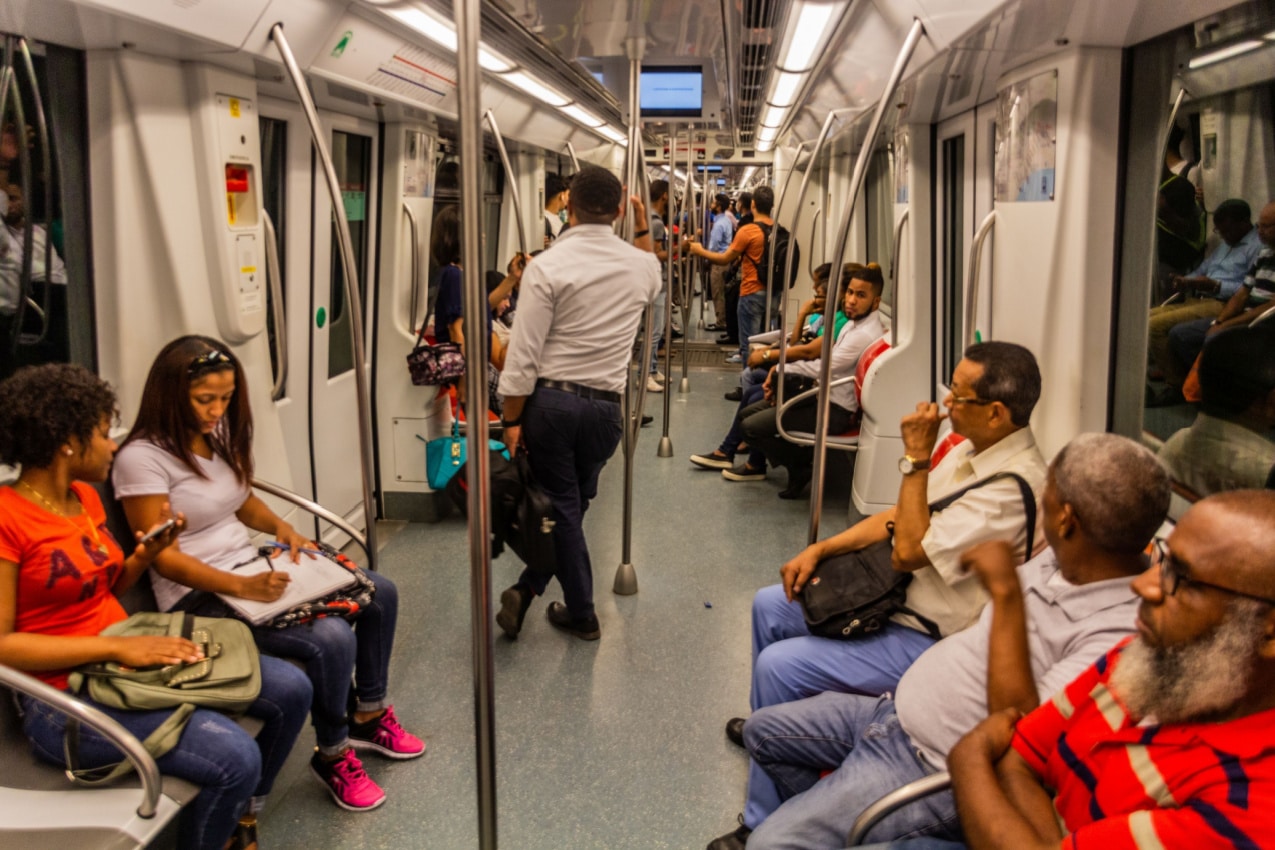
The public transport in the Dominican Republic is not safe. However, certified taxis are both reliable and safe. In terms of renting a car, keep in mind that there’s a high frequency of road accidents in the country.
According to the UK travel advisory :
- There are plenty of transport options available, like the expanded metro network in the country’s capital.
- Stay away from public buses and “carros publicos” (which are shared cars, driving along semi-fixed routes), as they’re neither safe nor secure.
- Private bus companies are completely safe , but they only provide intercity (between cities) bus services.
Public and Private Buses
The Canadian travel advisory advises against getting on public buses and gua-guas – microbuses. The latter often don’t even have doors, an additional safety concern.
Gua-guas are tiny, privately-owned buses that offer their services for either inner-city travel, or for longer destinations around the country. They are notoriously unsafe and unreliable.
Private buses, on the other hand, are quite safe and reliable. Unfortunately, they are only available for intercity travel.
Taxi Services
If you follow some simple safety tips, you’ll find that taxis are relatively safe thanks to the well-regulated taxi syndicate of the Dominican Republic .
However, make sure to only use official, marked taxis . Most of these are either beige or brown, but not always. There are over 20 official taxi companies in the country, and only official taxis can be called via telephone or a mobile app. The most famous companies are Apolo Taxi and Aero Taxi.
On the other hand, avoid using unofficial taxis at all costs . According to the Australian travel advisory, many travelers have been assaulted or robbed in unregistered taxis.
They also advise visitors not to use route taxis, better known in the Dominican Republic as carros publicos , since there’s a high chance of getting robbed. You can immediately spot carros publicos since they have no taxi markings, unlike the official taxis.
Additionally, avoid renting motorcycle taxis (motoconchos), as motor vehicle accidents are statistically more fatal than car accidents.
Lastly, keep in mind that taxis in the country are unmetered, which means that you should always negotiate the price before departure.
Renting a Car and Quality of the Roads
Finally, if you’re considering renting a car, keep in mind that the Dominican Republic has one of the highest road accident rates in the whole world. Drivers often drive while drunk and rarely respect traffic rules – including driving on the wrong side of the road! To top it all off, most vehicles are in bad condition.
According to the Canadian travel advisory , while most tourist hotspots have decent roads, less popular and less populated areas have roads of extremely poor quality.
The Quality of Medical Care in Dominican Republic
The quality of medical care in the Dominican Republic is decent in the larger cities but lacking in forlorn and rural areas. Also, private hospitals are generally better equipped and better-staffed than public medical establishments.
The Canadian travel advisory points out that private hospitals tend to overcharge for medical services. Prices might also be unstable and variable. Additionally, doctors may get a bit aggressive and pushy in their sales tactics, i.e., trying to sell you on their facility.
The best hospitals in the country, as previously stated, are located in larger cities, like Santo Domingo and its wider metropolitan area, as well as Puerto Plata. There are good hospitals in some of the smaller cities, too. Here’s a short list:
- Centro Médico UCE – Santo Domingo
- Hospital General de la Plaza de la Salud – Santo Domingo
- Hospiten Santo Domingo – Santo Domingo
- Hospital General Vinicio Calventi – Santo Domingo
- Centro Médico Bournigal – Puerto Plata
- Centro Médico Punta Cana – Punta Cana
- Hospital General de la Plaza de la Salud – Higüey
- Centro Médico Corominas – San Francisco de Macorís
- Centro Médico Cibao – Santiago
- Hospital Metropolitano de Santiago (HOMS) – Santiago
Dominican Republic, Here We Come!
You can have a great time visiting the Dominican Republic – provided that you keep your eyes open and exercise increased caution.
In short, don’t trust strangers, dating apps, public transportation, and unofficial taxis; don’t venture into dangerous or isolated areas; stay up-to-date on the weather forecast and follow safety protocols in case of natural disasters; be careful on the roads; don’t resist in case of theft; and finally, do bring a portable CO detector along with you. In case something unfortunate happens, you can rely on the police to help you out.
Basically, stick to the maxim “better safe than sorry,” and you’ll have a great trip in the Dominican Republic.
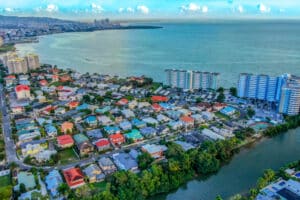
Trinidad and Tobago Safety 2024: Trinidad and Tobago Safe to Visit
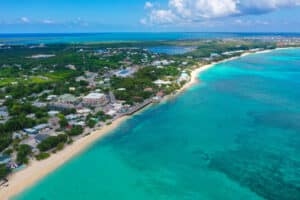
Cayman Safety 2024: Is Cayman Safe to Visit?
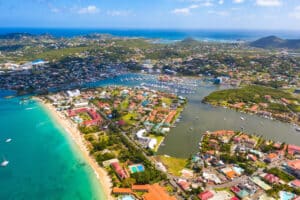
St. Lucia Safety 2024: Is St. Lucia Safe to Visit?
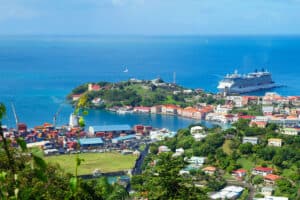
Grenada Safety 2024: Is Grenada Safe to Visit?
I moved to Punta Cana more than 7 years ago and have never felt unsafe. I have many expat friends that take public transportation buses all the time. And many use Uber we are out late several nights a week and have never had a problem. I feel safer here then I felt in the downtown of my Ontario city.
Hi Christine, thank you for reading and appreciate your first-hand feedback on the area!
Curious, I looked at Numbeo for my city, Washington, DC. It comes in at 70.86 So the DR and DC are on par. So treat the DR like any large US city. Be aware of your surroundings. No earbuds. Walk in groups.
Thank you for reading, Linette, and for your feedback.
Your email address will not be published. Required fields are marked *
Save my name, email, and website in this browser for the next time I comment.
We’re sorry, this site is currently experiencing technical difficulties. Please try again in a few moments. Exception: request blocked
- Meet the Team
- Work with Us
- Czech Republic
- Netherlands
- Switzerland
- Scandinavia
- Philippines
- South Korea
- New Zealand
- South Africa
- Budget Travel
- Work & Travel
- The Broke Backpacker Manifesto
- Travel Resources
- How to Travel on $10/day
Home » Central America » Travel Safety
Is Dominican Republic SAFE to Visit? (2024 • Insider Tips)
Rainforests, incredible beaches, savanna, highlands, and the highest mountain in the Caribbean; there’s no shortage of things that make the Dominican Republic an awesome place to travel.
It’s the most popular tourist destination in the Caribbean, but at the same time, is rife with poverty. Unfortunately, this dynamic leads to increased levels of crime; sometimes it’s pickpocketing, sometimes it’s a mugging. So asking the question ‘ is Dominican Republic safe ‘ makes sense.
Don’t worry.
Regardless if you’re wondering whether the Dominican Republic is safe for families, or if you want to know some tips for solo travel in the Dominican Republic, we’ve got you covered. All this and more will be addressed–so let’s get into it.
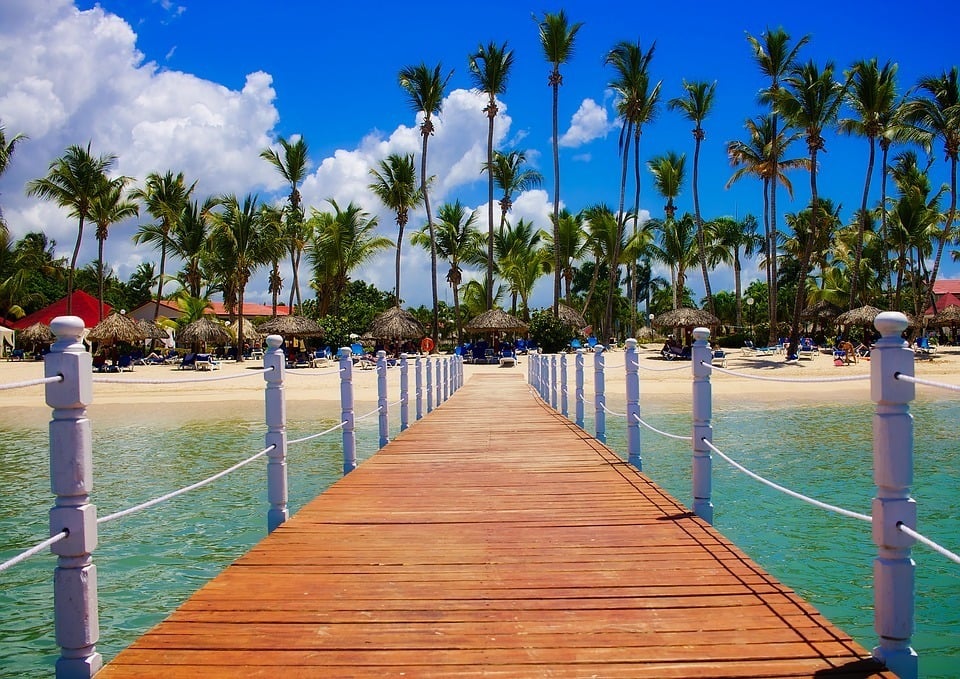
The Broke Backpacker is supported by you . Clicking through our links may earn us a small affiliate commission, and that's what allows us to keep producing free content 🙂 Learn more .
There is no such thing as a perfect safety guide, as things change quickly. The question of “Is Dominican Republic Safe?” will ALWAYS have a different answer depending on who you ask.
The information in this safety guide was accurate at the time of writing. If you use our guide, do your own research, and practice common sense, you will probably have a wonderful and safe trip to Dominican Republic.
If you see any outdated information, we would really appreciate it if you could reach out in the comments below. Otherwise, stay safe friends!
Updated December 2023
Is the Dominican Republic Safe to Visit Right Now?
Safest places in dominican republic, 26 top safety tips for traveling to the dominican republic, is the dominican republic safe to travel alone, is the dominican republic safe for solo female travelers, where to start your travels in the dominican republic, is the dominican republic safe for families, getting around dominican republic safely, crime in dominican republic, what to pack for your dominican republic trip, getting insured before visiting dominican republic, faq about staying safe in dominican republic, so, is the dominican republic safe.
Traveling to the Dominican Republic is pretty safe for tourists. Dominican Republic has a recorded 8,058,670 international visitors in 2023 based on their Ministry of Tourism. Tourists mostly received a hospitable welcome.
The people of the Dominican Republic are friendly and welcoming. Despite the huge amount on offer for the casual, resort dwelling tourist, there’s plenty on offer for backpackers , too. There are sleepy villages, trekking opportunities, and some amazing beach communities, to give just a few examples.
As a backpacker traveling outside resorts, you’ll see some extremes, namely in terms of poverty. You’ll see poor living conditions, people openly carrying weapons, litter, and possible threats to your safety, not to mention sex workers. This is more a sign of the fact that the Dominican Republic is still very much a developing country.
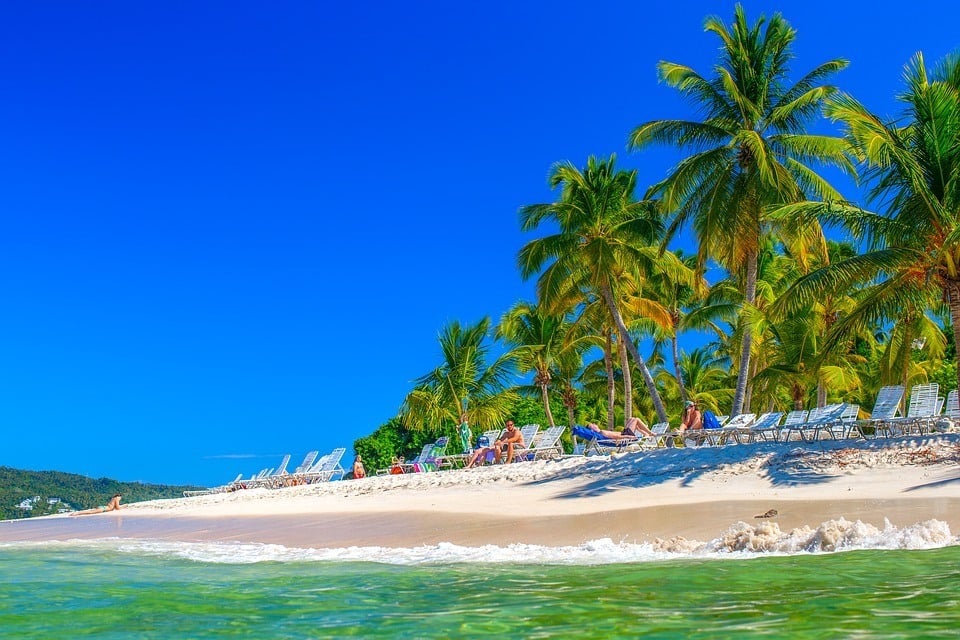
Unfortunately, poverty is a still an issue here. 20% of the population struggles to get by on $2 a day. Around 1/5 of all Dominicans live in shacks. Tourism may bring a lot of money to the country, but there are a lot of negative impacts as not every tourist is respectful of the locals. It’s partly your responsibility to make sure those serving you are taken of care of and to support local communities.
The Dominican Republic is known internationally for its sex tourism. In a 2015 study, the International Justice Mission found that roughly a quarter of all sex workers were under 18. There’s also a high rate of HIV and AIDS in comparison to other Central American and Caribbean countries.
The USA gives it a level 2 travel advisory because of violent crime and assault. But the reality is that most tourists never see this side of the island from the safety of their resorts.
As we said before, it’s safe to visit the Dominican Republic right now. Go enjoy the beauty of it; just but be aware of abusive and unethical businesses.
Check out our detailed where to stay guide for Dominican Republic so you can start your trip right!
When choosing where you’ll be staying in Dominican Republic, a bit of research and caution is essential. You don’t want to end up in a sketchy area and ruin your trip. These are some of the safest places in the DR:
- Punta Cana : The most famous place in the country, Punta Cana is filled with resorts for all budgets. It’s very much the tourist hub of the Dominican Republic, and absolutely the safest place to visit. Though if you’re looking for local life, keep in mind that Punta Cana is heavily commercialized.
- Puerto Plata : Puerto Plata is a charming destination on the North Coast of the island. Though definitely a city, the population is small enough to give it a laid-back vibe. It’s also known for its stunning beaches, many of which come with smaller crowds than those on the southern coast.
- Las Terrenas : Another northern destination, Las Terrenas is one of the safest cities in Dominican Republic offering huge beaches. It has low crime rates compared to other parts of the country and a thriving expat community.
- Santiago de los Caballeros : Known simply as Santiago to locals, this is the second-largest city in the Dominican Republic. Despite the sizable population, it offers a more laid-back alternative than Santo Domingo . It’s also one of the safest destinations in the Dominican Republic.
Places to avoid in Dominican Republic
The answer to How safe is Dominican Republic? is heavily dependent on where you go. And these places lie firmly in the category of “avoid at all costs”:
- Sections of Santo Domingo – while much of the capital city can be pretty safe during the day, we’d recommend avoiding it completely at night, and avoiding these areas altogether: La Duarte, Arroyo Hondo, Naco, Gazcue, Cristo Rey, and Villa Agricola.
- Any beach that has its danger flags raised – it might seem like a beautiful day and the waves are calling you, but don’t underestimate the currents and riptides. if you see warning flags, stay away from the water! Staying on the beach will be fine though.
- Empty side streets – these are especially dodgy at night, no matter where you are. If it doesn’t seem like tourists belong there, stay far away from it!
It’s important to know that Dominican Republic is pretty safe overall, but a bit of caution and research before you start your travels will go a long way. If you want to increase your safety during your stay, refrain from leaving a resort.
Keeping Your Money Safe in the Dominican Republic
One of the most common things to happen to you whilst travelling is losing your money. And let’s face it: the most annoying way for this to actually occur is when it’s stolen from you.
Petty crime is pretty much a problem all over the world.
The best solution? Get a money belt.

Stash your cash safely with this money belt. It will keep your valuables safely concealed, no matter where you go.
It looks exactly like a normal belt except for a SECRET interior pocket perfectly designed to hide a wad of cash, a passport photocopy or anything else you may wish to hide. Never get caught with your pants down again! (Unless you want to…)
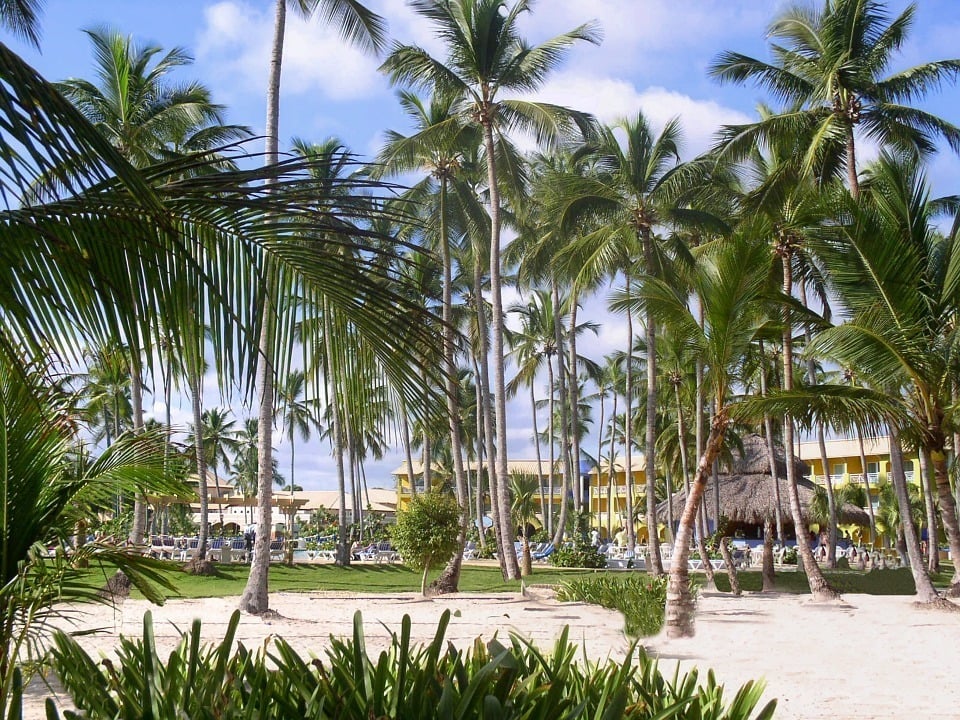
Though it’s a super popular destination for tourists, but the Dominican Republic isn’t without its problems. Violent crime against tourists, mainly in the form of robberies, definitely still occurs. By keeping your wits about you and making sure you travel safe and smart , you’ll likely avoid any trouble. To help you even more, here are some handy travel tips to safely travel in the Dominican Republic.
- Don’t walk by yourself at night time – Crime is more active after dark, beaches ESPECIALLY. Get a cab home.
- Don’t even TRAVEL at night – same.
- Flashing your cash in ANY way is a no-no – SLRs, phones, jewels, actually displaying large sums of money. These things make you look rich and therefore a target.
- Change your money at banks or official money exchange places – anything else is not recommended at all.
- Take a good medical kit with you – you never know when you might need it!
- Learn some of the local lingo – it’s not necessary, but if you plan on going off the beaten track, knowing some (Dominican) Spanish is a good idea.
- Get the relevant vaccinations before you head off – read up on what you’ll need and GET ‘EM.
- Keep your belongings close – pickpocketing happens in tourist areas, so be careful. Try investing in a money belt , and know how to safeguard your cash while travelling.
- Stay in gated communities – If you’re planning to stay in one of the best villas in the Dominican Republic , choose one in a gated community for added secirity.
- Prepare for hurricanes! – the season is between June and November and you should know how to deal with them. Listen to local advice and keep up to date with the weather…
- Protect against mosquitoes – mosquitoes carry dengue fever and chikungunyi, both of which are just nasty. Cover up and apply repellent.
- Avoid stray animals – rabies is a thing here so it’s best to not pet stray dogs and cats.
- Be aware of your surroundings at ATMs – people may try to look at your pin and then steal your card. Seems simple but it happens
- Always keep an emergency stash of cash – Never keep all your cards/ currency in one place. And hide it all from thieves with a hidden money belt .
- Stay safe in the sun! – it’s a hot place in the Caribbean. Sunscreen, shade, and hydration, people.
- And stay safe in the water – beaches often don’t have lifeguards. Currents and waves in hurricane season can be dangerous. Swimming drunk, for that matter, will put you in an even more disorienting situation.
- Take care on the roads – seriously: many people die on the roads in the Dominican Republic. The rate is 10 times that of the UK.
- Be careful around the Haitian border – especially if you intend to cross it. Research what you need to do when crossing so you don’t have to linger.
- DON’T talk about Haiti either – it’s a complex situation.
- Don’t take drugs – you don’t know WHAT it is, WHAT it funds, PLUS it’s illegal with hefty prison sentences to punish offenders.
- Practise safe sex – AIDS/HIV is a problem here. Always wrap up.
- Don’t pay for sex – you don’t know the situation, who’s getting the money, anything. Child prostitution is also a big problem.
- Get a room – public displays of affection are uncommon. Best not.
- Don’t resist if you get robbed/carjacked – this can unfortunately happen. If it DOES happen, hand over the goods. Your life is worth more than a rental car.
- Keep your wits about you in remote/residential areas – even in daylight hours. Muggings aren’t uncommon.
- Walk confidently – anything you can do to look less like a tourist is going to lessen the risk to your safety.
- Know what to do in an earthquake – they happen here. Take shelter, and if you’re near the beach, go to higher ground – a tsunami could arrive in minutes
- Use your room safe or locker – things can get snatched from your room. Best to keep it out of sight.
- Lock the doors and windows of your room – just in case.
So whilst there is a lot to keep in mind when you travel to the Dominican Republic, most visits to here are trouble-free. Plenty of backpackers love it for good reasons – it’s relatively calm in terms of the backpacking scene, there’s loads to do, and locals are mostly friendly.
Follow your gut and avoid getting into bad situations. Knowing what to do in a natural disaster will help, too. Do these and you will have a great time without worrying!
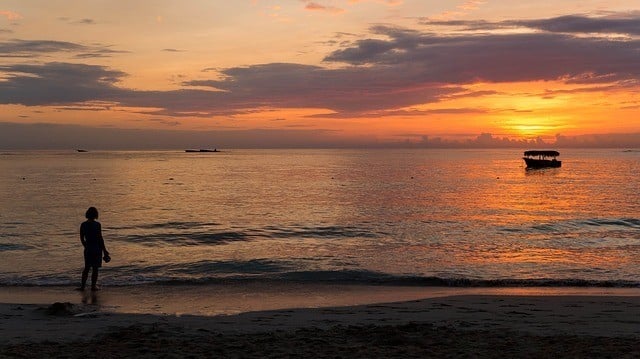
Backpacking is becoming more popular here and it’s easy to see why: humpback whales, colonial architecture, adventurous landscapes, and those beaches… Wowsers. That being said, solo travel in the Dominican Republic is as safe as one would expect.
Solo travelers are always a little more vulnerable so it’s important to be careful when you’re traveling around the Dominican Republic alone. It may be safe on the whole, but crimes against tourists aren’t uncommon and you’re more likely to be targeted when by yourself. Obviously, it pays to know HOW to travel solo in the Dominican Republic.
- It’s a good idea to hop on a tour to discover places easily and safely. Whether that tour may be a long or short one makes no difference – this is a great way to get acquainted with the island.
- Obviously, it’s down to how you want to travel. Resorts are safe, but you’ll be less likely to meet other backpackers. Punta Cana is good for nightlife, whilst Cabarete attracts a mix of travelers.
- Meeting other backpackers is a good idea. This will help you to keep sane and happy by talking to other like-minded people, plus you can share travel tips for the Dominican Republic – and/or further afield, too. Win-win.
- Going around by yourself at night time isn’t a very smart move. This is a good time for a robbery, though in some areas it doesn’t matter what time of day it is. The general rule of thumb here is to avoid walking through quiet/sketchy areas by yourself. Case closed.
- You might also want to get yourself a local guide. Not only will you be able to safely explore different areas of the Dominican Republic with someone who knows the local scene, but you’ll also get to learn A LOT more. Fumbling through your guidebook as you squint at bilingual signs is a both annoying and sometimes precarious.
- Be positive and friendly! Especially if you’re moving through more ‘local’ areas. Say ¡Hola! with a smile on your face and the country will open itself up to you, to an extent. Obviously, greeting some gang members chilling out at a mall in Santo Domingo isn’t smart, so use your common sense.
- If you’re a male traveling alone you may be approached by prostitutes. Be aware of this and say a firm “no” before moving on. Sex tourism has created this state of affairs, so don’t contribute any further.
- When you’re out at night, getting crazy drunk isn’t a good idea. You’ll lose your senses and be a lot more vulnerable to robbery or anything else unsafe.
- Tell someone at your guesthouse, or keep in touch with people at home, if you’re going out to explore more remote places. Someone knowing where you are is better than no one knowing where you are.
Though there are risks involved with traveling by yourself anywhere, the Dominican Republic is safe for solo travelers. Keeping your wits about you, meeting other people and even getting a local guide will really help you explore this country to the fullest. In the end, it’s an easygoing place that you’re going to love, and you’ll love it more if you stay safe!
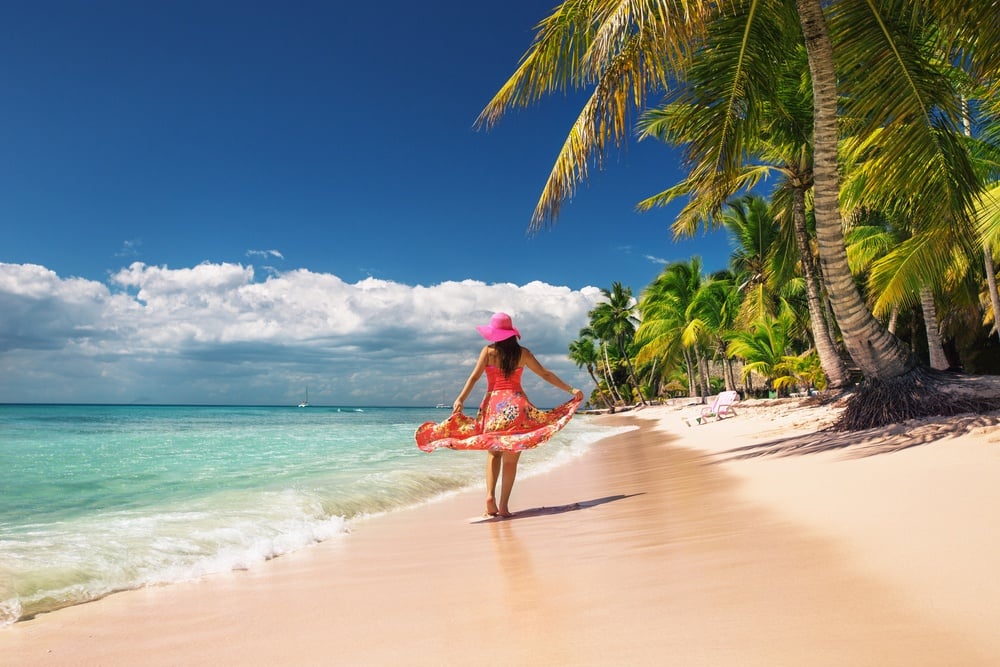
Whilst the Dominican Republican is used to solo female travelers, as many do visit here, there are some cultural dynamics to be aware of.
Local women struggle in the Dominican Republic due to a hyper-masculine society. In fact, many have emigrated to the US to escape this oppression. For female tourists, some could become the object of the same attention (and belittlement) as well.
To avoid becoming a victim of chauvinism or worse, it definitely helps to know how to stay safe as a female traveler . Here are a few tips on how to travel as a female in the Dominican Republic:
- Many people are friendly and speak English. Don’t be afraid to ask for help if you think something dodgy is going on around you, you’re lost, feel like you’re being followed – anything. People will be happy to help you.
- Walking around at night is not a good idea; don’t do it. Get a taxi or walk with people, but whatever you do, don’t wander around by yourself after dark.
- Dressing appropriately for the situation is a good idea; wandering around town in a bikini top and shorts is not, so we’d recommend against that. To avoid receiving to the wrong kind of attention, try blending in with the local women.
- Don’t take drinks from strangers. Drink spiking happens, so be careful.
- Men can be pushy in the Dominican Republic. In fact, they can be quite aggressive in their pick-up technique. This happens mainly in local bars and clubs. Our advice would be to dress conservatively and be firm in turning men down. At the same time, heading out to a local bar or club alone isn’t wise. Find some travel buddies to go with.
At the end of the day, backpacking as a solo female traveler ANYWHERE is “risky.” Being aware of your surroundings, making sure you don’t wander alone at night, and generally being smart with how you travel is going to make your trip safer.
It may have a macho society, but the Dominican Republic is safe for solo female travelers. You’ll be able to explore this amazing country safely, so get ready for some amazing times ahead!
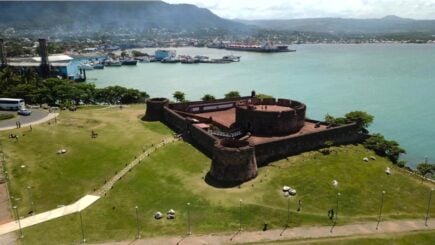
Puerto Plata
Puerto Plata may be small but it is still a city, so try to stay centrally for all of the best attractions. That being said, if you’re looking for peace and quiet then it’s worthwhile checking out the smaller villages nearby.
Completely! The Dominican Republic is very safe to travel for families. Parents and their children have been hitting up this popular destination for years – and continue to do so.
If you’re planning on staying in a resort area, and the only time you’ll be leaving is on a tour, then you won’t need to worry about anything except natural disasters. Not staying in the sun too long, being careful in the sea, not petting stray animals, protecting against mosquitoes , being careful around pool areas are easy to do to ensure that everyone stays happy.
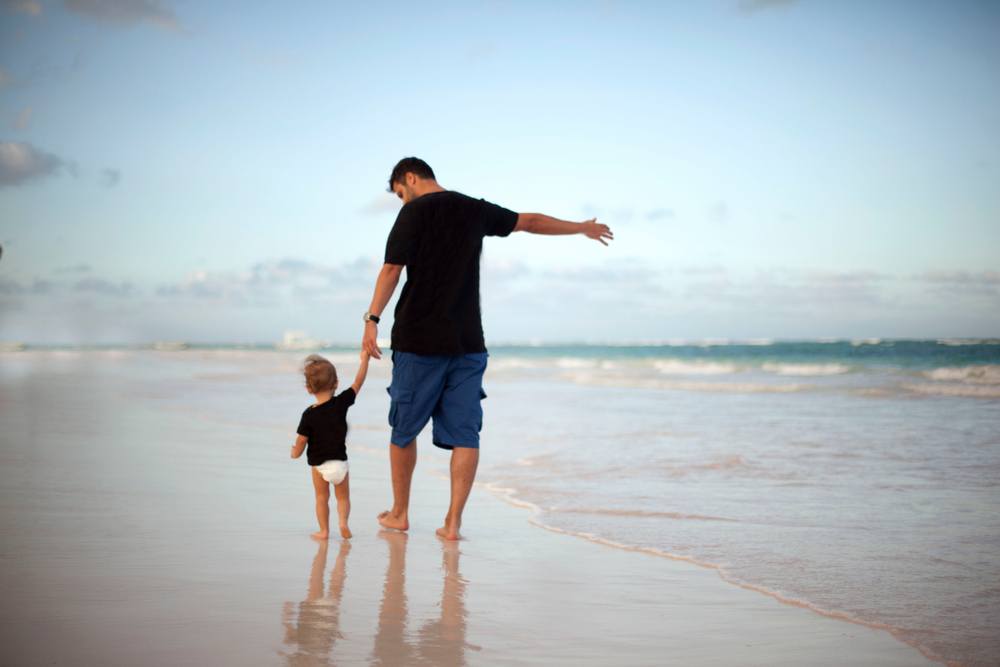
Just remember a few extra things to make sure your family holiday in the Dominican Republic is safe.
- The Dominican Republic is small so getting around is pretty easy.
- Cities aren’t very fun with children. They are hot and a hassle. However, there are many destinations in the Dominican Republic that are great for families.
- When it comes to child safety, there won’t be things like car seats for children.
- Breastfeeding is ok in public. Discretely, in a quiet spot, but not in a restaurant for example. Again if you’re in a resort, everywhere is ok.
One of the biggest dangers in the Dominican Republic is its roads. Well, the roads themselves are good, b ut the drivers are terrible.
Aggressive driving and a lack of road signs and traffic laws being enforced don’t help matters. Around 3,000 people are killed on the road per year according to WHO.
The taxis are surprisingly safe in the Dominican Republic.
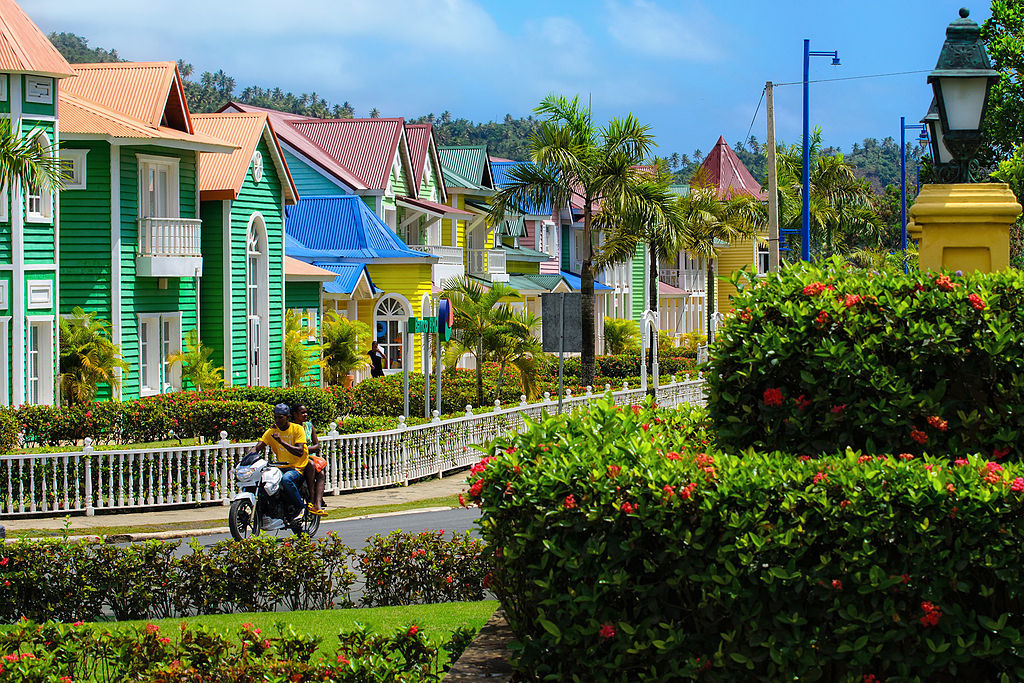
Drivers don’t cruise around looking for riders though – instead, you’ll find them at designated ranks near bus terminals, hotels, tourist areas, parks, and any other sort of big, official-looking place.
Public transport in the Dominican Republic is cheap, extensive, and highly varied. First off are the publicos . They don’t particularly have any signage designating them as publicos but you’ll know them when you see ’em. Safety isn’t the highest concern; they squeeze people on and drive erratically.
Buses in the bigger cities are pretty normal. However, overcrowding is common.
Then there’s the metro, which you’ll find in the capital, Santo Domingo. It doesn’t have to contend with traffic obviously, so it’s fast and safe. It’s clean, modern, comprehensive, and is expanding every year. This is by far Dominican Republic’s safest mode of public transport.
If you book a tour through a resort, most likely the transport you’ll encounter will be more luxury, and A LOT less crowded, than actual public options.
While the DR is far from being the most dangerous country in the world, crime is still a big issue. Armed robbery is the most common form of lawlessness, and it’s very important to be aware of valuables at all time.
Out of 197 countries, Dominican Republic is ranked 80th in terms of criminality, meaning there are a lot more dangerous nations out there. Even so, it’s ranked the 3rd most crime-ridden country in the Carribean, meaning you need to take more precautions than you would elsewhere.
In 2020, the DR had 9 homicides per 100,000 people , meanwhile the US had 7. So all in all, it’s really not as dangerous as the media may lead you to believe. Still, it’s important to avoid dangerous areas and walking around after dark.
Laws in Dominican Republic
The Dominican Republic is a Christian country with predominantly Catholic and Evangelical communities. As such, attitudes toward LGBT communities are not the best, though relations are not illegal.
It’s also important to note that the Dominican Republic has strict laws regarding drugs–everything including weed is illegal. You can find weed and other goodies easily, though be extremely careful as this will likely involve dealing with shady characters.
Everyone’s packing list is going to look a little different, but here are a few things I would never want to travel to Dominican Republic without…

Hanging Laundry Bag
Trust us, this is an absolute game changer. Super compact, a hanging mesh laundry bag stops your dirty clothes from stinking, you don’t know how much you need one of these… so just get it, thank us later.

A decent head torch could save your life. If you want to explore caves, unlit temples, or simply find your way to the bathroom during a blackout, a headtorch is a must.

Yesim stands as a premier eSIM service provider, catering specifically to the mobile internet needs of travellers.

Monopoly Deal
Forget about Poker! Monopoly Deal is the single best travel card game that we have ever played. Works with 2-5 players and guarantees happy days.

This is a regular looking belt with a concealed pocket on the inside – you can hide up to twenty notes inside and wear it through airport scanners without it setting them off.
ALWAYS sort out your backpacker insurance before your trip. There’s plenty to choose from in that department, but a good place to start is Safety Wing .
They offer month-to-month payments, no lock-in contracts, and require absolutely no itineraries: that’s the exact kind of insurance long-term travellers and digital nomads need.

SafetyWing is cheap, easy, and admin-free: just sign up lickety-split so you can get back to it!
Click the button below to learn more about SafetyWing’s setup or read our insider review for the full tasty scoop.
Here are some quick answers to common questions about safety in Dominican Republic.
What should you avoid in the Dominican Republic?
Avoid these things in the Dominican Republic to stay safe: – Don’t walk by yourself at night time – Don’t even TRAVEL at night – Avoid looking rich and flashy – Don’t withdraw money at night – be careful around ATMs
Is the Dominican Republic safe to live?
Many parts of the island are super safe to live in and have thriving expat communities. Do your research and visit a couple of times before making the decision though.
Is the Dominican Republic safe at night?
We wouldn’t recommend walking around at night in the Dominican Republic. While some parts can be safe, it’s always best to take a bit of extra caution. If possible, stick to a group and use taxis to get around after dark.
Is Jamaica or Dominican Republic safer?
If caution is taken, both places can be very safe for travellers. If you just look at the crime statistics, then Jamaica is slightly safer than the Dominican Republic.
Can you drink the water in Dominican Republic?
NOPE! Tap water is definitely not safe to drink in the Dominican Republic. Buy water from stores, or invest in an epic filtered water bottle .
The Dominican Republic is the star player of Caribbean tourism and CAN be safe – if you use your common sense and do a bit of research.
It’s well established as a tourist destination, people are very, very used to foreigners, and a lot of locals speak English. All-in-all, the Dominican Republic is a pretty safe place to travel to. But poverty, combined with an influx of relatively rich tourists, has meant that robberies committed against visitors aren’t all that rare.
At the end of the day, it’s all about how you travel, and we’d recommend you do so SMARTLY. That means not being flashy or cocky . Showing any money, a wallet, wearing expensive jewelry, carrying designer bags, shouting around in English, looking lost; all of these are to be avoided.
Millions of people travel to the Dominican Republic each year. Away from the tourist areas, the crazy scenery opens itself up as a haven for backpackers looking for an adventure in the backyard of an otherwise well-trodden, cruise-ship-visited destination. Our insider guide is full of tips of how to go about keeping safe in the Dominican Republic, so you’ll get to explore with peace of mind.
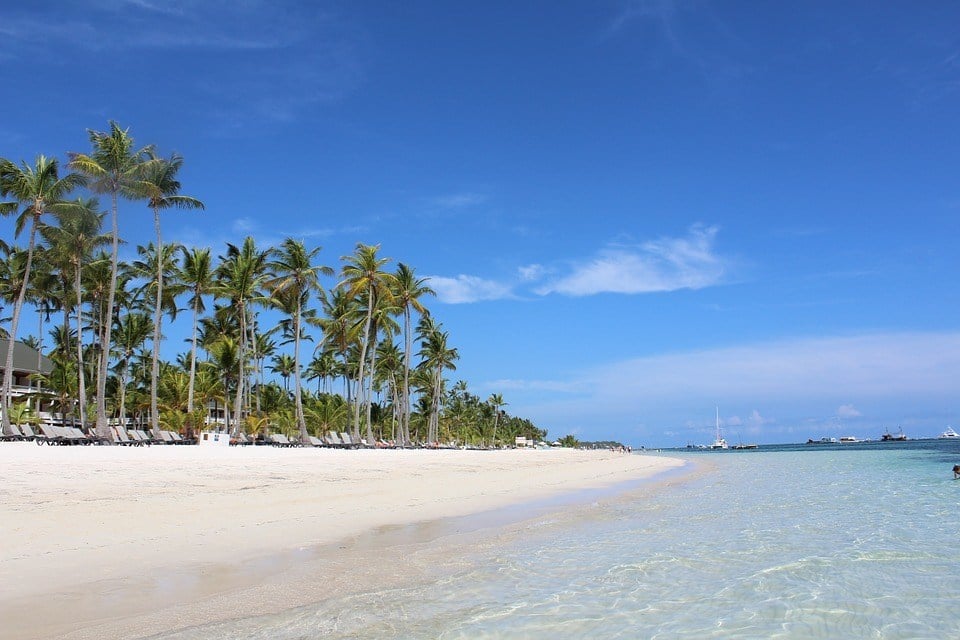
Looking for more info on traveling to Dominican Republic?
- Let me help you choose where to stay in Dominican Republic
- Explore with the ultimate peace of mind with top-notch medical evacuation insurance
- Take a look at my expert travel safety tips learned from 15+ years on the road
- See exactly how to travel the world for a year , even if you’re broke
- Get inspired by these EPIC bucket list adventures !
Disclaimer: Safety conditions change all over the world on a daily basis. We do our best to advise but this info may already be out of date. Do your own research. Enjoy your travels!

Lily Allen-Duenas
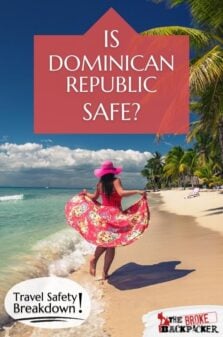
Share or save this post

12 Comments
I would suggest renting a car or SUV at the airport for two or more people is safe. Hope they take Amex. I’m going there next week. I will be driving the whole country with my wife but I will also take a local guide who speaks very good English. If guide or driver won’t speak good English it becomes very awkward. I own a condo in gated community and airbnb once in a while. This will be my seventh trip. I have seen all the cities and they all have different terrain and beaches. Taxis are not cheap but safe. Buses are not safe and get crowded. But tour buses are great. I took a bus from Santo Domingo to Puerto Plata and taxi to Boca Chica. Our bus broke down and we had to wait for one hour in 90 degree for replacement bus. Having said that all. I think Dominican Republic is still a normal caution country if you are street smart. I travelled more than 20 countries and Dominican Republic is worth going.
Went to DR in January 2020. I returned to USA right before Covid-19. While I was there, I stayed in Santo Domingo, and northern parts of the country and my experiences were totally wonderful. I did use Uber and taxis for transportation as well as transportation offered at my lodging. Like in others countries, including the USA have delinquencies and we should be aware of our surroundings. In Paris, France and Rome, Italy have a lot of pickpockets I will definitely be back to DR.
I spend 3 years in The DR before moving to Thailand. It was my second choice. I never felt unsafe in the DR but like anywhere you have to keep your wits about you. Great article.
The worst situation is in Punta Cana and all other large resorts as well. Since there are thousands of tourists in and out of these hotel rooms, there is a massive bedbug problem (covered up of course) throughout all of these resorts. The normal way that bedbugs are killed in Canada and USA for example, is a bedbug sniffing dog identifies the infected room. Then a technician is called in with a specialized heater/timer/thermometer setup that basically raises the room temperature so hot that the bedbugs “pop” and are killed. You can imagine the expense and time to do 8000 rooms. So, in DR it doesn’t happen that way. Instead they buy poisonous pellets from/made in china. The room cleaning staff open these packets and when they are exposed to air start to emit an extremely poisonous gas into the room. This saves time and money. This poison will kill a person also. It is supposed to be used days before the room is occupied, but in DR they will just just do it anytime, the cleaning staff have no idea the room will be occupied in just hours perhaps. This poison is the cause of many tourists deaths each year. Governments of Canada, USA etc know this but play dumb anyway. The pellets are light green, sometimes under the mattresses or in corners not so easy to vacuum up. Beware of these big resorts in this regard. Your health is up to you only. Medical fees must be paid as the service is rendered upfront. Goodluck trying to collect on your travel insurance anywhere outside of your own country until you get back to your country.
I’m here in the DR now, and for a second time. So far my experience has been great. The only problem I am having is conversion of my USD to Dominican pesos. I’d suggest learning exactly how the currency works, as most places will rip you off.
Sorry to say just back after two weeks and I absolutly agree with the notion of never returning. I travel a lot and attitudes here are so bad its just not worth it.
My wife hated the constant purvy staring, I hated being ripped off at their every opportunity. Add in the ever-present dangers from both locals and tsunami (20 minor quakes during my stay all at sea) means this is not a viable holiday destination.
You really do put yourself, and your wallet, in serious harm’s way. Why bother when there are many better places to spend your time and money.
I find I am very sensitive to danger or possible danger when I travel abroad. I have lived in Asia for 14 years, and learned to read people before learning Mandarin. I have visited Cuba, and while it seemed safe… I had the feeling that if I decided to wander off alone, things could go badly very quickly… especially at night.
China didn’t have this feeling overall, Philippines was moderate (depending on region), and Thailand overall felt a little worse than the Philippines. I believe the Dominican Republic would be similar to Cuba in that respect.
The most annoying and highly harassing types would flock to the outside of resorts areas. So I can see why it is the same in the DR. As soon as you leave one, they cover you like flies… asking if you need a ride constantly or to eat their restaurants… or whatever else.
My advice to simply get away from the heavy tourist areas in exchange for more remote but hints of tourism. For example in the Philippines – You go to Boracay and you will be harassed all day long… same with Krabi in Thailand… but if you go to Coron in the Philippines (newer tourist area) or Pai (outside of Chiang Mai) in Thailand (no massive resorts, mostly locally owned accommodations) – You will find extreme beauty, kindness and much less of the parasitical types. Because either not enough tourists go there for them to harass or the locations haven’t made a name for themselves yet.
Go to smaller towns or cities that are just opening up as tourist hubs. They may not be as convenient as the larger resorts or cities… but your experience will most likely be A LOT better.
I’ve also been in Asia for 20 years, mostly based in Bangkok, a fantastic city and an excellant springboard to the whole of Asia. I’m forced to say your advice really isn’t representative of Thailand at all. Keep your wits about you of course but don’t limit your destinations because of a few locals selling junk at the gates – of wherever you happen to be. Thailand is about as safe as it gets (never get on or use a bike).
Its a shame you are so sensitive Robert as in my 20 years the only fights I’ve seen have been in the ring, of course I don’t drink in western pubs or the Khaosan road so my exposure is limited :).
If you really want to discuss danger look at NASA’s report in Dominican Today – you simply cannot compare that to Thailand; or in fact any of the other comments left here.
I’m off to DR. If you don’t hear back, send lawyers guns and money!
Keep safe friend, its a wild world 🙂
The area outside the resort is NOT safe, especially if you are a white female. Double that if you are blonde/blue eyed and/or pale-skinned. The girls in our group were subject to unwanted attention and sexual harassment constantly. And almost everyone who isn’t a sex pervert is trying to scam you or make you spend money in some way at businesses they are promoting
I visited DR once and while the island is beautiful I will never return. Corrupt police set up a roadblock the night we arrived as a way to take money from tourists because they were “out of gas” might as well set up a toll road. Taxi drivers take you to edge of town then demand more money. Only safe if you stay in your resort but then how much fun is it to visit a new destination if you locked down in the resort. No thanks.
Leave a Reply Cancel reply
Your email address will not be published. Required fields are marked *
Save my name, email, and website in this browser for the next time I comment.
Notify me of followup comments via e-mail.
Update April 12, 2024
Information for u.s. citizens in the middle east.
- Travel Advisories |
- Contact Us |
- MyTravelGov |
Find U.S. Embassies & Consulates
Travel.state.gov, congressional liaison, special issuance agency, u.s. passports, international travel, intercountry adoption, international parental child abduction, records and authentications, popular links, travel advisories, mytravelgov, stay connected, legal resources, legal information, info for u.s. law enforcement, replace or certify documents.
Before You Go
Learn About Your Destination
While Abroad
Emergencies
Share this page:
Dominican Republic
Travel Advisory June 6, 2023
Dominican republic - level 2: exercise increased caution.
Reissued with updates to health information.
Exercise increased caution in the Dominican Republic due to crime.
Country Summary: Violent crime, including armed robbery, homicide and sexual assault is a concern throughout the Dominican Republic. The development of a professional tourist police corps, institution of a 911 system in many parts of the country, and a concentration of resources in resort areas means these tend to be better policed than urban areas like Santo Domingo. The wide availability of weapons, the use and trade of illicit drugs, and a weak criminal justice system contribute to the high level of criminality on the broader scale.
Read the country information page for additional information on travel to the Dominican Republic.
If you decide to travel to the Dominican Republic:
- Be aware of your surroundings.
- Do not physically resist any robbery attempt.
- Do not display signs of wealth, such as wearing expensive watches or jewelry.
- Follow the advice of resort and tour operators regarding local safety and security concerns.
- Enroll in the Smart Traveler Enrollment Program (STEP) to receive Alerts and make it easier to locate you in an emergency.
- Follow the Department of State on Facebook and Twitter .
- Review the Country Security Report for the Dominican Republic.
- Prepare a contingency plan for emergency situations. Review the Traveler’s Checklist .
- Visit the CDC page for the latest Travel Health Information related to your travel.
Embassy Messages
View Alerts and Messages Archive
Quick Facts
Passports must be valid for the period of stay in the Dominican Republic.
1 page required for entry stamp
Not required for visits shorter than 30 days
None required if arriving from the United States
$10,000 and over or its equivalent must be declared
Embassies and Consulates
U.s. embassy santo domingo.
Av. República de Colombia #57 Santo Domingo, Dominican Republic Telephone: +(809) 567-7775 Emergency After-Hours Telephone: +(809) 567-7775, dial zero (0) ask for Duty Officer Email: [email protected] Hours: Monday through Friday from 7:00 AM to 4:00 PM except U.S. and Dominican holidays
Consular Agencies
U.S. Consular Agent - Puerto Plata Plaza el Doral, carretera Luperón KM 3 1/2 Puerto Plata, Dominican Republic Telephone: +(809) 586-4204, +(809) 586-8023 Emergency After-Hours Telephone: (809) 567-7775, dial zero (0) ask for Duty Officer Email: [email protected] Hours: Monday through Friday from 8:00 AM to 5:00 PM except U.S. and Dominican holidays
U.S. Consular Agent - Bavaro/Punta Cana Palma Real Shopping Center Business Center 2nd Floor Bavaro, La Altagracia, Dominican Republic Telephone: (809) 552-8990 Emergency After-Hours Telephone: +(809) 567-7775, dial zero (0) ask for Duty Officer Email: [email protected] Hours: Monday through Friday from 8:00 AM to 5:00 PM except U.S. and Dominican holidays
Destination Description
Learn about the U.S. relationship to countries around the world.
Entry, Exit and Visa Requirements
Visas are not required for visits shorter than 30 days. Visit the Embassy of the Dominican Republic website for current visa information.
All visitors to the Dominican Republic are charged a $10 tourist card fee that is incorporated into airline charges. Cruise passengers must obtain a tourist card if they are disembarking for longer than 24 hours. Once used, the card allows for stays up to 30 days but can be extended at the General Directorate of Migration in Santo Domingo.
Contact the Migration Department in Santo Domingo for visa extension requests. Failure to request an extension will result in a fine at the airport upon departure. The fines range from approximately $55 USD for one month to as high as $1,555 USD for overstays of 10 years or more.
All passengers are required to fill out an E-Ticket or paper form when entering or exiting the Dominican Republic. If using E-Ticket, a new form is required for each entry and exit and the code generated upon form completion can be presented at the airport on a digital device.
Visitors must have a ticket entering and leaving the country, the financial means to pay for their stay, and an address in the Dominican Republic where they will be staying.
Exit Requirements for Children: Minors (children under 18) who are citizens (including dual citizens) or legal residents of the Dominican Republic, if not accompanied by both parents or legal guardian(s), are required to present official proof of parental consent to travel. Please see the Dominican Migration Department's website for detailed instructions on the required documents.
HIV/AIDS Restrictions: Some HIV/AIDS entry restrictions exist for visitors to and foreign residents of the Dominican Republic. The Dominican Republic has restrictions on granting residency to people with HIV/AIDS. Please verify information with the Dominican Republic’s Migration Department before you travel.
Yellow Fever Vaccine: Proof of vaccination against yellow fever is required for travelers entering the Dominican Republic from Brazil. Similar requirements may apply to those traveling from other countries with yellow fever risk .
Find information on dual nationality , prevention of international child abduction , and customs regulations on our websites.
Safety and Security
Crime: Crime is a threat throughout the Dominican Republic. Tourist destinations are generally more policed than metropolitan areas.
- If robbed, hand over your personal belongings without resisting.
- Do not carry or wear valuable items that will attract attention.
- Be wary of strangers.
- Travel with a partner or group if possible.
International Financial Scams: See the Department of State and the FBI pages for information.
Dating App Robberies: Several U.S. citizen travelers in the Dominican Republic have reported that they were robbed by people they met through popular online dating applications. If meeting with strangers, you should strongly consider meeting only in public places and avoiding isolated locations where crimes are most likely to occur.
Demonstrations: Avoid areas of demonstrations and exercise caution if you are in the vicinity of large gatherings or protests.
Victims of Crime: Report crimes to the local tourist police (POLITUR) at 809-222-2026 or 911 and contact the U.S. Embassy at 809-567-7775. 911 is operational throughout the country apart from some areas located near the Haitian border. Remember that local authorities are responsible for investigating and prosecuting crime.
See our webpage on help for U.S. victims of crime overseas .
- Help you find appropriate medical care.
- Assist you in reporting a crime to the police.
- Contact relatives or friends with your written consent.
- Provide general information regarding the victim’s role during the local investigation and following its conclusion.
- Provide a list of local attorneys.
- Provide our information on victim’s compensation programs in the U.S.
- Provide an emergency loan for repatriation to the United States and/or limited medical support in cases of destitution.
- Replace a stolen or lost passport.
Domestic Violence: U.S. citizen victims of domestic violence are encouraged to contact POLITUR (809-222-2026), the National Police ( 809-682-2151), and the U.S. Embassy for assistance.
Sexual Assault: Rape and sexual assault has been reported throughout the Dominican Republic, including at major resorts and hotels.
Notes for your safety:
- U.S. citizens have been targeted with date rape drugs.
- Sexual assault victims in the Dominican Republic should not expect the totality of assistance offered in the United States. Rape kits are often not available until the following morning and must be administered by Dominican authorities.
- Victims often have to request medication to avoid transmission of STDs and reduce the chances of pregnancy.
- Prosecution of a rape case moves forward very slowly. Dominican law may require the victim to return to the Dominican Republic at some stages of the judicial process.
- Security outside of the resort area, including beach areas, is unpredictable, especially at night.
Best Practices:
- Contact the police/hotel management if resort staff demonstrate unwanted attention.
- Victims of sexual/other assault should contact the police and the Embassy. Insist that hotel management take immediate action by contacting the police.
- In a resort, avoid secluded places. Always be accompanied by someone you know, even going to the restroom.
- Do not consume alcoholic beverages alone or with new acquaintances. Do not leave drinks unattended. Know your limits and help your friends/travelling companions to remain safe.
- Shout for help immediately if threatened or made uncomfortable.
- Report suspicious activity, including excessive friendliness by hotel employees, to hotel management, the U.S. Embassy, and local police.
- Do not swim alone due to life-threatening undertows.
Tourism: The tourism industry is unevenly regulated, and safety inspections for equipment and facilities may not commonly occur in all parts of the country. Hazardous areas and activities are not always identified with appropriate signage, and staff may not be trained or certified either by the host government or by recognized authorities in the field. In the event of an injury, appropriate medical treatment is typically available only in or near major cities or major tourist zones. First responders may be unable to access areas outside of major cities or major tourist zones. The ability to provide urgent medical treatment may be limited. U.S. citizens are encouraged to purchase medical evacuation insurance. See our webpage for more information on insurance providers for overseas coverage .
Local Laws & Special Circumstances
Criminal Penalties: You are subject to local laws. If you violate local laws, even unknowingly, you may be expelled, arrested, or imprisoned. Individuals establishing a business or practicing a profession that requires additional permits or licensing should seek information from the competent local authorities, prior to practicing or operating a business.
Furthermore, some laws are also prosecutable in the United States, regardless of local law. For examples, see our website on crimes against minors abroad and the Department of Justice website. Penalties for possessing, using, or trafficking illegal drugs in the Dominican Republic are severe, and convicted offenders can expect long jail sentences and heavy fines. Arrest Notification: If you are arrested or detained, ask police or prison officials to notify the U.S. Embassy immediately. See our webpage and general information on legal assistance for further information.
Counterfeit and Pirated Goods: Although counterfeit and pirated goods are prevalent in many countries, their possession they may still be illegal according to local laws. You may also pay fines or have to give them up if you bring them back to the United States. See the U.S. Department of Justice website for more information.
Faith-Based Travelers: See the following webpages for details:
- Faith-Based Travel Information
- International Religious Freedom Report – see country reports
- Human Rights Report – see country reports
- Hajj Fact Sheet for Travelers
- Best Practices for Volunteering Abroad
LGBTI Travelers: There are no legal restrictions on same-sex sexual relations or the organization of LGBTI events in the Dominican Republic.
See our LGBTI Travel Information page and section 6 of our Human Rights report for further details.
Travelers with Disabilities: The law in the Dominican Republic prohibits discrimination against persons with physical, sensory, intellectual or mental disabilities, but the law is not enforced consistently. Social acceptance of persons with disabilities in public is not as prevalent as in the United States. Accessible facilities, information, communication/access to services and ease of movement is limited in most parts of the country. Large resorts and Santo Domingo may have some generally accessible infrastructure, but travelers should not expect the level available in the United States.
Students: See our Students Abroad page and FBI travel tips .
Women Travelers: See our travel tips for Women Travelers .
Disaster Preparedness: Register with the Embassy on or before your arrival through our travel registration website . In the event of a natural disaster or emergency, this will keep you informed. Additional information on natural disasters and disaster preparedness can be found on our website. Real Estate: Property rights are irregularly enforced, and investors often encounter problems in receiving clear title to land. Consult a reputable attorney before signing documents or closing on any real estate transactions. Real estate investments by U.S. citizens have been subject to legal and physical takeover attempts. Absentee landlords and absentee owners of undeveloped land are particularly vulnerable. Consider purchasing title insurance. Scams: Scammers often target elderly people by pretending to be a law enforcement official, an attorney, or a U.S. Embassy official, claiming that a loved one has been arrested overseas. The caller instructs the victim to wire money. Scammers sometimes impersonate family members, such as a scared grandchild. Contact the U.S. Embassy before wiring money to the Dominican Republic. When in doubt, try to contact your loved one directly.
For emergency services in the Dominican Republic, dial 911 or 809-202-2026 .
Ambulance services:
- The training and availability of emergency responders may be below U.S. standards.
- Ambulances are not present or reliable in most areas of the country. They are more reliable and available in Santo Domingo, Santiago, Punta Cana, and Puerto Plata.
We do not pay medical bills. Be aware that U.S. Medicare/Medicaid does not apply overseas. Most hospitals and doctors overseas do not accept U.S. health insurance.
Medical Insurance: Make sure your health insurance plan provides coverage overseas. Most care providers overseas only accept cash payments. See our webpage for more information on insurance providers for overseas coverage. Visit the U.S. Centers for Disease Control and Prevention for more information on type of insurance you should consider before you travel overseas.
We strongly recommend supplemental insurance to cover medical evacuation.
Always carry your prescription medication in original packaging, along with your doctor’s prescription. Check with the Ministry for Public Health to ensure the medication is legal in the Dominican Republic.
Vaccinations: Be up-to-date on all vaccinations recommended by the U.S. Centers for Disease Control and Prevention.
Further health information:
- World Health Organization
- U.S. Centers for Disease Control and Prevention (CDC)
Air Quality: Visit AirNow Department of State for information on air quality at U.S. Embassies and Consulates.
The U.S. Embassy maintains a list of doctors and hospitals . We do not endorse or recommend any specific medical provider or clinic.
Health facilities in general:
- Public medical clinics lack basic resources and supplies.
- Hospitals and doctors require payment “up front” prior to service or admission.
- Private hospitals usually require advance payment or proof of adequate insurance before admitting a patient.
- Be aware that some hotels, resorts, etc. have exclusive agreements with medical providers, which have costs associated and may limit your choices in seeking emergency medical attention.
- Medical staff may speak little or no English.
- Generally, in public hospitals only minimal staff is available overnight in non-emergency wards. Consider hiring a private nurse or having family spend the night with the patient, especially a minor child.
- Patients bear all costs for transfer to or between hospitals.
- Psychological and psychiatric services are limited, even in the larger cities, with hospital-based care only available through government institutions
Medical Tourism and Elective Surgery
U.S. citizens have suffered serious complications or died during or after having cosmetic or other elective surgery.
If you are considering travel to the Dominican Republic for cosmetic surgery, be mindful of the following:
- Have a medical evaluation from a U.S. doctor to determine if you are a good candidate for surgery.
- Before travel, carefully research the doctor (e.g. qualifications, experience performing the surgery, complication rate) and credentials of the recovery facility you plan to use.
- Share all health information (e.g. medical conditions, medications, allergies) with your doctor before your surgery.
- Obtain international travel insurance that covers medical evacuation back to the United States and repatriation of remains. For more information, see: https://wwwnc.cdc.gov/travel/page/insurance .
- See a travel medicine professional in the United States at least 4–6 weeks before your trip to discuss healthy travel and to learn about specific risks related to your surgery and travel. For more information on the risks of medical tourism, see: https://wwwnc.cdc.gov/travel/page/medical-tourism .
- Your legal options in case of malpractice are very limited in the Dominican Republic.
Tap Water: Tap water is unsafe to drink. Bottled water and beverages are considered safe. Please note that many restaurants use tap water for ice.
Adventure Travel
- Visit the U.S. Centers for Disease Control and Prevention website for more information about Adventure Travel .
General Health
The following diseases are prevalent:
- Tuberculosis
- Chikungunya
Visit the U.S. Centers for Disease Control and Prevention website for more information about Resources for Travelers regarding specific issues in the Dominican Republic .
Travel and Transportation
Road Conditions and Safety: Driving conditions vary across the country. Drive defensively and with extreme caution.
Consider hiring a professional driver instead of driving yourself. You can hire licensed drivers who are familiar with local roads through local car rental agencies. In case of accidents, normally only the driver will be taken into custody. In 2019 six people died per day due to traffic accidents in the Dominican Republic.
Frequent hazards include:
- other drivers not using headlights and/or taillights after dark
- animals in the road
- missing manhole covers and large potholes
- uneven road surfaces
- scooters and motorcycles driving erratically and splitting lanes
- driving on sidewalks or against traffic
- intersections without stop signs
- unregulated and congested traffic patterns
- speeding or the running of stoplights
- heavy urban traffic
Traffic Laws: Traffic laws are not enforced consistently. After an accident causing serious injury or death, authorities will often take the driver into custody, even if the driver is insured and appears to have not been at fault. Detentions frequently last until a judicial decision has been reached or until a waiver has been signed by the injured party.
Seat belts, and helmets for motorcyclists, are required by law. Violators may be fined. There are no child car seat laws. Police stop drivers using cell phones without a hands-free device.
Public Transportation: Public transportation includes a metro and public bus system as well as shared bus or van taxis known as “guaguas” (converted vans or microbuses, often without doors). Guaguas run regular routes within urban areas and between towns in the countryside. Public buses and guaguas operating in the capital do not meet U.S. safety standards. Avoid unregulated taxis, which also often lack basic safety features. Use a reputable taxi service, either one recommended by your hotel or a well-known, vetted company. Rideshare services such as Uber are available in many parts of the country. Private bus lines travel between large cities and to popular tourist destinations.
See our Road Safety page for more information. Visit the website of the Dominican Republic’s Ministry of Tourism and INTRANT (Instituto Nacional de Transito y Transporte Terrestre) the national authority responsible for road safety.
Aviation Safety Oversight: The U.S. Federal Aviation Administration (FAA) has assessed the government’s Civil Aviation Authority as being in compliance with International Civil Aviation Organization (ICAO) aviation safety standards for oversight of the Dominican Republic’s air carrier operations. Further information may be found on the FAA’s website. FAA’s safety assessment page .
Maritime Travel: The U.S. Coast Guard has concerns about the security practices in the ports of the Dominican Republic. Until those concerns can be addressed, the Coast Guard advises that Mariners and passengers on commercial vessels traveling through the ports of the Dominican Republic should exercise caution.
Mariners planning travel to the Dominican Republic should also check for U.S. maritime advisories and alerts . Information may also be posted to the U.S. Coast Guard homeport website , and the NGA broadcast warnings .
For additional travel information
- Enroll in the Smart Traveler Enrollment Program (STEP) to receive security messages and make it easier to locate you in an emergency.
- Call us in Washington, D.C. at 1-888-407-4747 (toll-free in the United States and Canada) or 1-202-501-4444 (from all other countries) from 8:00 a.m. to 8:00 p.m., Eastern Standard Time, Monday through Friday (except U.S. federal holidays).
- See the State Department’s travel website for the Worldwide Caution and Travel Advisories .
- Follow us on Twitter and Facebook .
- See traveling safely abroad for useful travel tips.
Review information about International Parental Child Abduction in Dominican Republic . For additional IPCA-related information, please see the International Child Abduction Prevention and Return Act ( ICAPRA ) report.
Travel Advisory Levels
Assistance for u.s. citizens, dominican republic map, learn about your destination, enroll in step.

Subscribe to get up-to-date safety and security information and help us reach you in an emergency abroad.
Recommended Web Browsers: Microsoft Edge or Google Chrome.
Make two copies of all of your travel documents in case of emergency, and leave one with a trusted friend or relative.
Afghanistan
Antigua and Barbuda
Bonaire, Sint Eustatius, and Saba
Bosnia and Herzegovina
British Virgin Islands
Burkina Faso
Burma (Myanmar)
Cayman Islands
Central African Republic
Cote d Ivoire
Curaçao
Czech Republic
Democratic Republic of the Congo
El Salvador
Equatorial Guinea
Eswatini (Swaziland)
Falkland Islands
France (includes Monaco)
French Guiana
French Polynesia
French West Indies
Guadeloupe, Martinique, Saint Martin, and Saint Barthélemy (French West Indies)
Guinea-Bissau
Isle of Man
Israel, The West Bank and Gaza
Liechtenstein
Marshall Islands
Netherlands
New Caledonia
New Zealand
North Korea (Democratic People's Republic of Korea)
Papua New Guinea
Philippines
Republic of North Macedonia
Republic of the Congo
Saint Kitts and Nevis
Saint Lucia
Saint Vincent and the Grenadines
Sao Tome and Principe
Saudi Arabia
Sierra Leone
Sint Maarten
Solomon Islands
South Africa
South Korea
South Sudan
Switzerland
The Bahamas
Timor-Leste
Trinidad and Tobago
Turkmenistan
Turks and Caicos Islands
United Arab Emirates
United Kingdom
Vatican City (Holy See)
External Link
You are about to leave travel.state.gov for an external website that is not maintained by the U.S. Department of State.
Links to external websites are provided as a convenience and should not be construed as an endorsement by the U.S. Department of State of the views or products contained therein. If you wish to remain on travel.state.gov, click the "cancel" message.
You are about to visit:

Is It Safe to Travel to the Dominican Republic Amid the Crisis in Haiti?
As haiti endures severe unrest and political upheaval, travelers may be wondering what the situation on the ground is like in the neighboring dominican republic..
- Copy Link copied

Travelers flock to the Dominican Republic for its beauty, beaches, culture, and cuisine.
Courtesy of Jean Estrella/Unsplash
A new wave of gang violence is wreaking havoc on the streets of Haiti. Thousands of residents have been forced to flee Port-au-Prince, police stations have been set ablaze , and there is widespread call for the resignation of de facto leader Prime Minister Ariel Henry. Haiti is in the midst of one of its worst crises to date, and travelers may be wondering whether or not it’s safe to visit both Haiti and its Caribbean neighbor, the Dominican Republic.
For the past two years, Haiti has been suffering from widespread gang violence, which escalated in the aftermath of the assassination of President Jovenel Moise in 2021. Most recently, the head of the G9 Haitian gang alliance, Jimmy “Barbecue” Cherizier, made a statement in early March that if Prime Minister Henry does not resign, civil war and genocide could be on the horizon.
The U.S. State Department issued a Level 4 travel advisory for the country last July and that remains firmly in place. Level 4 is the highest advisory level, urging U.S. citizens to avoid travel to the country altogether due to the possibility of kidnapping, crime, civil unrest, and because of the country’s poor healthcare infrastructure.
While State Department travel advisories are often not the clearest indicators of whether or not a destination is safe, this time it would appear that travelers ought to proceed with extreme caution or, even better, heed the advice to the letter.
“I’d say that now is not the time to be visiting Haiti,” says Stephen Bennett, a Caribbean destination expert and cofounder of Uncommon Caribbean, an online resource for Caribbean travel. “The primary airports in the capital, Port-au-Prince, and Cap-Haitien, more than 120 miles to the north, remain closed, so flying there isn’t an option at present.”
However, Bennett confirmed that he feels it is completely safe to visit the Dominican Republic at this time and does recommend travelers keep their travel plans there. The Dominican Republic shares its western border with Haiti, although the border between the two countries remains closed with heightened security and border patrols.
The U.S. State Department last updated its travel advisory to the Dominican Republic on June 6, 2023. Since then, it remains at a Level 2 , which encourages visitors to exercise increased caution. Many other popular tourist destinations have also been ranked at a Level 2 advisory, including Denmark, Costa Rica, Turks and Caicos, France, Germany, Italy, and others.
Mark Chesnut, a travel writer who specializes in the Caribbean, just returned from a trip to the Dominican Republic, including to Santo Domingo, which is the largest city closest to the Haitian border.
“I have visited Santo Domingo and the [Dominican Republic] many times over the past 30 years and during my most recent visits to both Santo Domingo and Punta Cana, I didn’t feel any different about my sense of security,” he says. “On the Dominican Republic television, there is tons of news about the border, so I was more aware of the situation because of the news, but I didn’t have a sense of a different level of danger in the DR. The crisis was a topic of conversation among locals and hotel staff, but none of them warned about increased security measures. I didn’t feel any difference in safety related to that situation.”

Prior to the current escalation in violence, Labadee was a popular cruise port in Haiti.
Courtesy of Patrice S. Dorsainville/Unsplash
Amid Haiti travel advisory, how cruise lines and airlines are responding
Haiti, however, is a different situation.
At present, JetBlue, American Airlines, and Spirit have canceled their flights into Haiti. Sunrise Airways announced on Instagram that it will operate special flights between Cap-Haitien and Miami beginning again on March 25.
Up until last week, Royal Caribbean still had calls to Labadee on the northern coast of Haiti scheduled into its upcoming itineraries. However, the cruise line has suspended upcoming calls to the port as of March 14.
“Due to the evolving situation in Haiti, and in an abundance of caution, we’re temporarily suspending our visits to Labadee for our entire fleet,” Royal’s assistant vice president Aurora Yera-Rodriguez said in a statement. “We continue to monitor and assess the situation with our global security and intelligence team.”
Royal Caribbean Group owns Celebrity Cruises and Silversea. The port of call in Labadee is a private port accessible only to cruise passengers and employees. It features a day-use resort with multiple beaches, a zip line, and other facilities.
Bennett says that officials at Sunrise Airways, which operates regularly scheduled flights throughout the country, have expressed hope that airports will reopen soon. Once that happens, Cap-Haitien, which Sunrise serves nonstop from Miami, will begin operations for visits to Haiti in the short term.
“The city’s proximity to several of Haiti’s top visitor attractions, combined with its extended stance from the crux of the tumult in Port-au-Prince should make it a viable option more quickly,” he said. He noted that the distance between Cap-Haitien and Port-au-Prince is further than the distance from New York City to Philadelphia, for a bit of perspective.
Still, an immediate solution feels far away. According to Human Rights Watch, the country is on the brink of “total collapse .” Criminal groups hold power in the country now and have killed more than 1,100 people since the beginning of 2024, reports the United Nations. Between January 2022 and early March 2024, 13,000 people have been killed, injured, or kidnapped. Thousands of women and children have been the victims of sexual violence, and hundreds of thousands of people are displaced.
According to Reuters, the U.S. and Canadian embassies have reduced their staff , leaving only essential employees in the country, and the embassies are temporarily closed to the public. For now, travelers are forced to alter their plans to visit Haiti because getting there is impossible. In the near future, should that change, deciding whether or not it is safe to visit will depend on how the situation evolves in the coming months.

Choose your language

Dominican Republic up close
Is It Safe to Visit the Dominican Republic?
Dominican fruit vendor, La Romana
Photo: Rafal Cichawa / Alamy Stock Photo
The Dominican Republic is America’s second-favorite country to visit, with more than 2.7 million Americans traveling the Dominican Republic each year. Together with tourists from Europe and elsewhere, some 6.5 million people visit annually.
There's plenty to see and experience here, and local people often go out of their way to help visitors - whether you're in a tourist area or not. But as with every trip to a new destination, a few safety tips can keep you even more safe and secure, and offer extra peace of mind.
Dominican girls in Sosúa
Photo: Viveronelle / Shutterstock.com
Is it really safe to travel to the Dominican Republic?
We say yes. Between 2018 and 2019, the Dominican Republic rose seven points on the Global Peace Index. This puts the country's rank of 84 someplace between Switzerland (11) and the United States (128). It's considerably safer to visit the Dominican Republic than to be a tourist in many other destinations, including Brazil, Mexico, South Africa, India, and yes - even the United States.
Because the Dominican Republic relies heavily on tourism as part of its economy, the government goes to great lengths to keep the country as tourist-friendly as possible. For example, you’re not required to get a tourist visa if you’re a citizen of the United States, Canada, Japan, or most European countries. In 2019, The Travel and Tourism Competitiveness Index (TTCI) ranked the Dominican Republic (DR) in the global top ten countries prioritizing tourism and travel.
The TTCI also awarded "the most improved country in the subregion" to this island nation "thanks to above-average regional and global improvement on 11 pillars." The most notable improvement was in the categories of Cultural Resources and Environmental Sustainability.
There's so much to see on this beautiful island beyond the beaches and resorts, and if you're looking for an adventure, it's perfectly feasible to head out onto the paths less traveled. However, there are a few things you should keep in mind to stay safe (and healthy!). Many of these tips you probably use in your hometown anyhow, especially if you're coming from a major U.S. metropolis.
Nighttime view of Santo Domingo
Photo: José Miguel Pérez
How to stay safe as a traveler
Just like you should in any city or tourist hotspot, use extra precaution while drinking at bars. Don't leave your drink unattended, accept drinks from strangers, or get intoxicated with new friends. Take someone you know to the bathroom with you, even at a resort.
Try not to wear or use expensive items in public, and don't leave your bag or phone accessible from the window of a vehicle.
Try not to carry valuables in your pockets. Crossbody bags are commonly used in the Dominican Republic. Just wear yours to the front. It won't draw undue attention.
In April 2019, the US State Department issued a Level 2 travel advisory for the Dominican Republic. The advisory recommends increased caution to avoid daterape and robbery of personal effects. It also warns tourists to limit any personal danger caused by excessive inebriation.
A colmado in Santo Domingo
Photo: Aleksei Denisov / Shutterstock.com
How to stay healthy as a traveler
Remember! Tap water is not consumed in the Dominican Republic. Everyone drinks bottled water. Juices made fresh on the street are incredibly tempting in the heat, but the ice is usually made from tap water, so these are best avoided.
You might also want to avoid food trucks and vendors, as their hygiene standards probably won't be as high as at Dominican restaurants and resorts. Your local cafe will have most of the same street snacks and juices that are tempting you, without the risk of upsetting your stomach.
Traffic comes under staying healthy! Polite drivers observe the pedestrian right of way, but not everyone. Once you do start to cross, look closely for the approach of motorcycles, as they zip between lanes.
Traveler taking photos, Los Haitises National Park
Photo: Ksenia Neyman / Alamy Stock Photo
Is there internet? Can I use my phone?
Travelers can access wifi at most major hotels and many boutique accommodation options. If you’re planning to use it often or use lots of data, you might want to check the cost of wifi while you’re browsing for accommodation - many places do offer free wifi, at least up to a point.
There are thousands of free wifi hotspots around the Dominican Republic, with good coverage in big cities and major destinations including Santo Domingo, Punta Cana, La Romana, Santiago de los Caballeros and San Pedro de Macoris.
Picking up a signal in McDonald's or a cafe is a great idea, but for more reliability, consider roaming with your regular phone carrier. You can always put your phone in airplane mode when you don't need it.
Most US phones unlocked for global use will work in the Dominican Republic, although charges for international calls and data roaming vary. Check willmyphonework.net first to see if the internet frequencies used in the Dominican Republic are compatible with your phone.
If your phone is unlocked for global use, you'll have a way better signal if you swap your sim card temporarily for a local prepaid card. The phone carrier with the best coverage is Claro. A Claro sim card will cost you just 150 pesos (about US $2.85*).
People swimming at Saona Island
Photo: Ryan Bowen
Why travel to the Dominican Republic?
The Dominican Republic is home to some of the best-ranked beaches on the planet , world-famous Dominican cigars, coffee and chocolate, a proud heritage of major-league baseball stars, and a love of good food, dancing, and enjoying the good life.
The north coast of the Dominican Republic is home to some of the world's most popular beaches for surf-lovers. The wind blows all year round and the winter months whip up some serious rolling waves. Every February, the world's best surfers, windsurfers and kitesurfers hit Playa Encuentro to compete at the Master of the Ocean surfing tournament.
Inland, the Dominican Republic is packed full of wild tropical forests, vibrant small towns and picturesque mountain paths just waiting to be explored. There’s so much to see and do beyond the resorts, from mountain biking and hiking to caving and white-water rafting.
Colonial history buffs can stroll the five-hundred-year-old Colonial Zone in downtown Santo Domingo, or visit the Catedral Primada de América - the oldest cathedral in the Americas. For those more interested in indigenous roots, there’s dozens of sites of cultural significance for the native Caribbean Taíno peoples, and plenty of living culture too, which you can glimpse in festivals like Carnaval.
Throughout their history of colonization, slavery, piracy and dictatorships on the journey to becoming a free republic, Dominicans have demonstrated incredible warmth, resilience, entrepreneurial spirit and generosity.
Get out beyond the resorts and soak up some real Caribbean culture and adventure. Visit the Dominican Republic.
Written by GA.
Published December 2021
Looking for Some Cool Things to Do?
Centro león museum and cultural centre.
Get out to Santiago De Los Caballeros to experience Centro
Your Guide to Kitesurfing in Cabarete
One of the original kitesurfing meccas, Cabarete in the Dominican
The Dominican Street Food You Have to Try
Yaniqueques, Chimis and Yaroas - Here’s our guide to the
Hit the beach in Boca Chica
The oceanside town of Boca Chica has long drawn tourists
Cotubanamá National Park (Parque del Este)
One of the top day-trips from Punta Cana, the Cotubanamá
Fun Things to do in Punta Cana
Find the Best Activities in Punta Cana for your next
How to do La Romana (beyond the resort!)
Most tourists who visit La Romana don’t venture beyond the
Where to Drink & Dance in Santiago de los Caballeros
Dive into Santiago de los Caballeros' nightlife scene: top bars,
How to See the Whales in Samaná Bay
If you're in the Dominican Republic between January and March,
Best Bird Watching Sites in Dominican Republic
Our Best Selections for Your Dominican Birdwatching Checklist
Subscribe to our newsletter
Get more travel inspiration, tips and exclusive offers sent straight to your inbox
I would like to get Visit Dominican Republic newsletters in my inbox
Paradise for Your Inbox
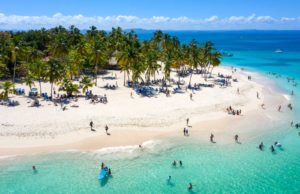
Subscribe to our newsletter for the best monthly stories and insider guides about the Dominican Republic!
- Today's news
- Reviews and deals
- Climate change
- 2024 election
- Fall allergies
- Health news
- Mental health
- Sexual health
- Family health
- So mini ways
- Unapologetically
- Buying guides
Entertainment
- How to Watch
- My watchlist
- Stock market
- Biden economy
- Personal finance
- Stocks: most active
- Stocks: gainers
- Stocks: losers
- Trending tickers
- World indices
- US Treasury bonds
- Top mutual funds
- Highest open interest
- Highest implied volatility
- Currency converter
- Basic materials
- Communication services
- Consumer cyclical
- Consumer defensive
- Financial services
- Industrials
- Real estate
- Mutual funds
- Credit cards
- Balance transfer cards
- Cash back cards
- Rewards cards
- Travel cards
- Online checking
- High-yield savings
- Money market
- Home equity loan
- Personal loans
- Student loans
- Options pit
- Fantasy football
- Pro Pick 'Em
- College Pick 'Em
- Fantasy baseball
- Fantasy hockey
- Fantasy basketball
- Download the app
- Daily fantasy
- Scores and schedules
- GameChannel
- World Baseball Classic
- Premier League
- CONCACAF League
- Champions League
- Motorsports
- Horse racing
- Newsletters
New on Yahoo
- Privacy Dashboard
Here’s What You Need To Know About The Travel Advisory For The Dominican Republic
The Dominican Republic has been a hotspot for Black travelers for a long time. Whether for medical tourism, business, or pleasure, the DR has become one of the culture’s favorite international, tropical destinations. However, the US State Department is warning travelers planning on visiting anytime soon.
On Tuesday, June 6, the agency issued a level 2 travel advisory for the Caribbean country. According to its website , the department warns of “violent crime, including armed robbery, homicide, and sexual assault is a concern throughout the Dominican Republic.”
Regional Efforts To Address Crime
Despite being a prime destination for American travelers, the DR has been a hotspot for crime for quite some time. According to Dialago Americas , leaders from Central America, Mexico, and the Dominican Republic came together in April to strategize against crime in the countries.
“These criminal phenomena are not new. What is new is that we are confronting them regionally,” Guatemala’s Minister of the Interior David Napoleón Barrientos told Guatemalan Daily Prensa Libre. “Each of the countries has its own strategies. We’ve discussed and shared them […]; the idea is to generate regional plans and protocols. This will be done by each country’s specialists at the roundtables.”
While the meeting in April centered more around organized crime and drug and human trafficking, the new US travel advisory focuses on the numerous accounts of sexual assault from American tourists visiting the DR.
According to USA Today, one American woman claims she was drugged and sexually assaulted while in the Dominican Republic . The tourist says she ordered a drink at a bar and lost recollection of what happened after she received it. Unfortunately, the travel advisory warns Americans that rape prosecution in the Dominican Republic varies greatly from legalities in the States.
“Sexual assault victims in the Dominican Republic should not expect the totality of assistance offered in the United States,” the travel advisory said. The advisory also tells travelers not to resist robbery attempts and to follow all local rules and regulations to avoid harm.
Safety Tips For Travel To The Dominican Republic
Areas near resorts and tourist attractions are safer than urban areas like Santo Domingo, the advisory states. The advisory does state that since the creation of the country’s 911 hotline, some areas of the Dominican Republic are safer than others. However, travelers should still avoid dark, secluded areas, and beaches at night.
Travelers should also take precautionary measures when using local taxi services and utilize rideshare apps like Uber instead.
Recommended Stories
Timberwolves coach chris finch calls jamal murray's heat-pack toss on court 'inexcusable and dangerous'.
Murray made a bad night on the court worse during a moment of frustration on the bench.
Former NBA guard Darius Morris dies at 33
Former NBA guard Darius Morris has died at the age of 33. He played for five teams during his four NBA seasons. Morris played college basketball at Michigan.
The FDIC change that leaves wealthy bank depositors with less protection
Affluent Americans may want to double-check how much of their bank deposits are protected by government-backed insurance. The rules governing trust accounts just changed.
Former House Speaker Paul Ryan says he’s not voting for Trump : 'Character is too important'
Ryan says he would be writing in a Republican candidate instead of voting for Donald Trump.
Ranking the best situations for the rookie quarterbacks: Start with Michael Penix in Atlanta at No. 1
It’s key to note that we’re not saying the “best team” or “best roster.” Instead, we’re talking about the best confluence of factors that can outline a path for survival and then success.
Phil Mickelson on the majors: 'What if none of the LIV players played?'
Phil Mickelson hints that big changes could be coming to LIV Golf's rosters, and the majors will need to pay attention.
Blockbuster May trade by Padres, MVP Ohtani has arrived, Willie Mays’ 93rd birthday & weekend recap
Jake Mintz & Jordan Shusterman discuss the Padres-Marlins trade that sent Luis Arraez to San Diego, as well as recap all the action from this weekend in baseball and send birthday wishes to hall-of-famer Willie Mays.
Heat's Pat Riley unhappy with Jimmy Butler's remarks on Celtics and Knicks, implies he needs to play more
Miami Heat president Pat Riley rebuked comments Jimmy Butler made about the Boston Celtics and New York Knicks, while also implying that his star needs to play more.

NBA playoffs: Officials admit they flubbed critical kick-ball call in controversial final minute of Pacers-Knicks
Tuesday's last-2-minute report should be interesting.
Social Security just passed Medicare as the government's most pressing insolvency risk
An annual government report offered a glimmer of good news for Social Security and a jolt of good news for Medicare even as both programs continue to be on pace to run dry next decade.

Is The Dominican Republic Safe?
Welcome to our Dominican Republic safety guide.
This Caribbean nation has been one of the hottest beach destinations on the planet for several decades, and here there are tons to see and do.
In the capital of Santo Domingo we can see all kinds of colonial architecture, as well as enjoy the beautiful Tres Ojos caves with their crystal-clear green and blue waters .
The northern beaches around Samaná and Puerto Plata are world-class, whilst we can also get to know the real Dominican culture by hitting up places like Santiago de los Caballeros.
The Dominican Republic Quick Summary:
- 📍 Where is it: The Caribbean
- 🗺 Difficulty Getting There: Very Easy
- ⏱ Time needed: 10-14+ Days
- ☀️ Best Time to Visit: November-April

What's in this guide?
In this comprehensive guide, we’ll explore everything you’ll need to know about Safety in the Dominican Republic as a backpacker or traveler .
We’ll look at all the different factors, our top safety tips, other useful information as well as an FAQ section where we answer your key questions.
We would advise any travelers who are thinking of heading to the Dominican Republic to prepare properly before arriving, and to get in touch with us where we can offer more guidance.
Is the Dominican Republic Safe Right Now?
Quick Answer: Yes, but this popular nation can vary in terms of safety. Areas like Punta Cana (and around Puerto Plata) remain safer, given they heavily depend on tourism.
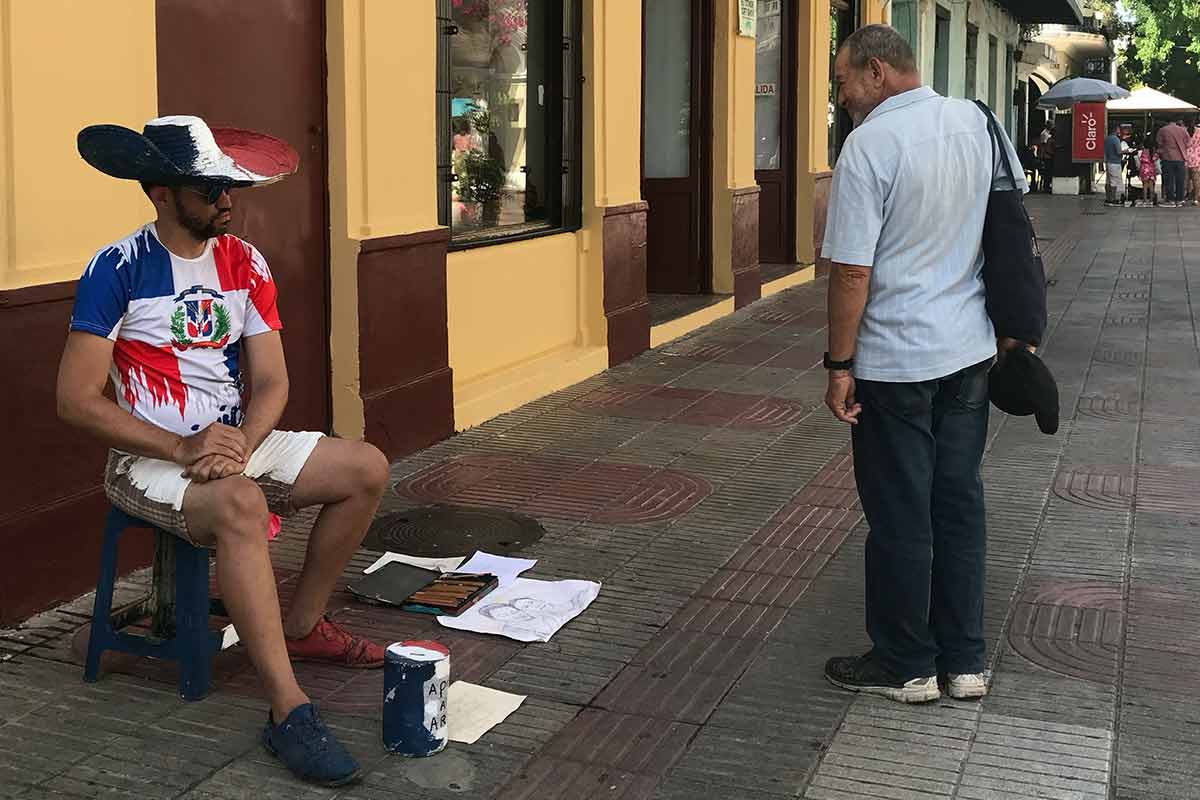
Crime can be an issue in areas of Santo Domingo, so it’s important to stay in safer districts such as the Zona Colonial. If heading around the city, then be sure to leave valuables back in your accommodation, as well as to dress down to avoid attracting unwanted attention from potential thieves.
There are other things to keep in mind when traveling around the Dominican Republic, which we’ll explore later in this guide.
Where to Stay in the Dominican Republic
In general, the Dominican Republic is well-catered for luxury tourism, especially since it’s one of the best-selling Caribbean destinations out there. However there are plenty of hostels too , which means backpacking is definitely possible (although the Dominican Republic will be more expensive than other parts of Latin America).
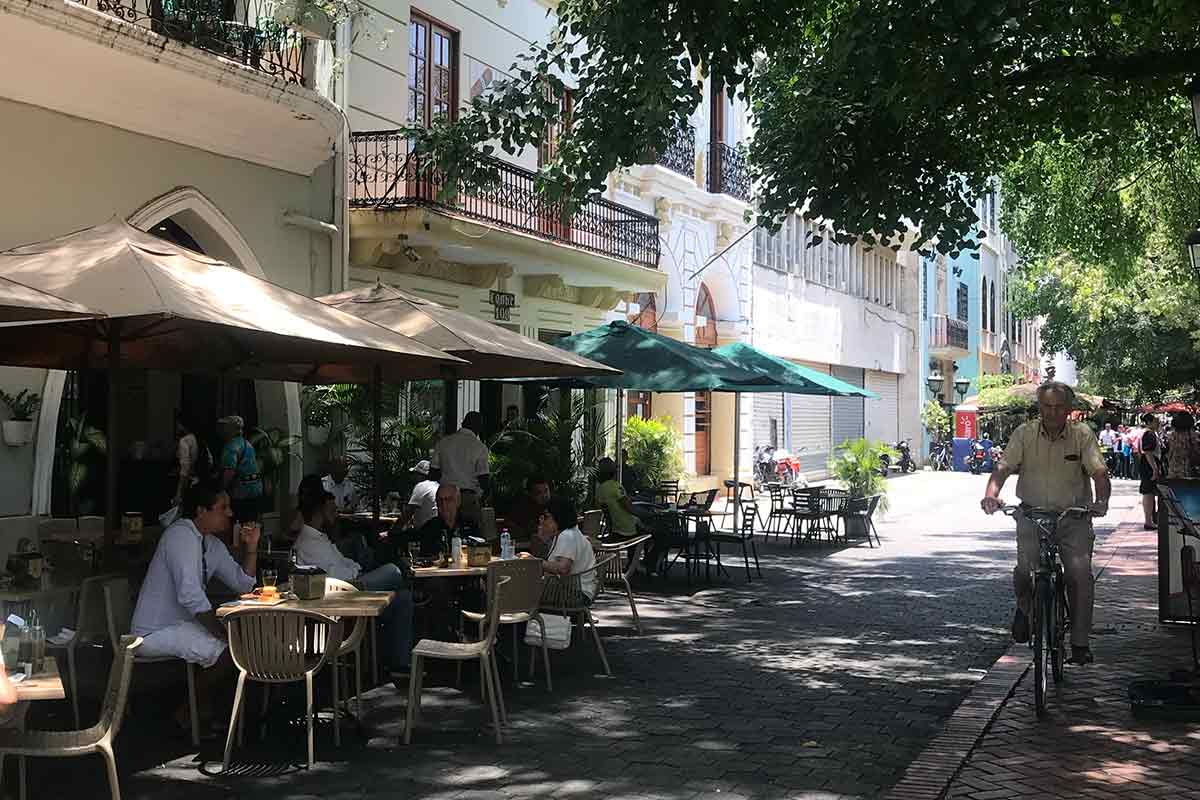
In Santo Domingo, the Zona Colonial is the best area to stay in (it’s the safest and is full of local attractions). Those on a backpacking budget will want to stay at the Chao Mamá Hostel , which is in a perfect location and has private rooms at a budget price.
If you’re after more luxury, then consider the Hotel Colonia . Situated right next to the bustling Parque Colón, here you’ll be staying in a beautifully decorated private room with an en-suite bathroom.
When it comes to beach destinations, we’ll find plenty around the island. However Las Terrenas remains one of the very best, which is located along the Samaná Peninsula. Hostel 23 is a great option for those on a low budget, where you’ll be staying within the heart of the town with an on-site bar and garden to enjoy.
If you fancy an upgrade, then the Casa Brisa Mar Hotel is a perfect option, where you’ll be staying in a deluxe private room right on the white sands of Punta Popy Beach.
Things to do in the Dominican Republic
This Latin island is famous for its range of incredible beaches, and we think that they are some of the best in the Western Hemisphere .
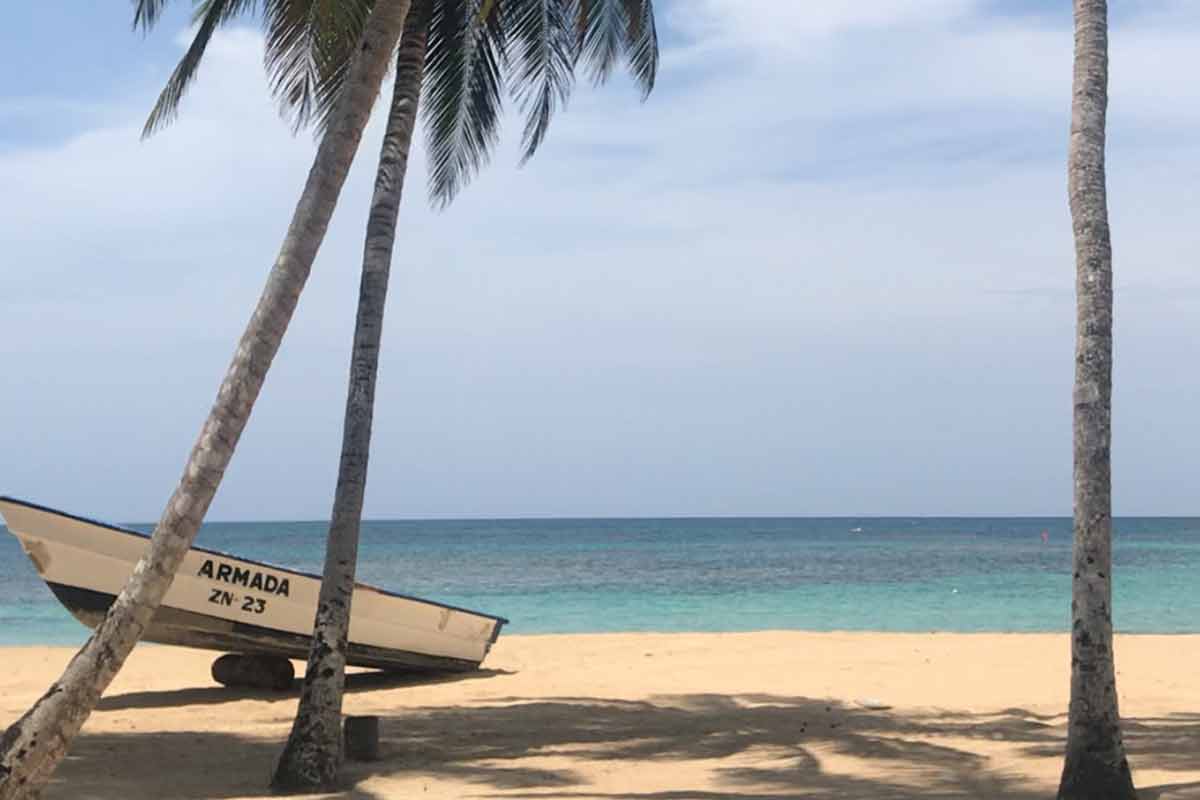
Those in the Samaná Peninsula are some of the best, including Punta Popy Beach (Las Terrenas) as well as Playa Rincón. You’ll also want to head on a day trip to Saona Island too, which is close to Punta Cana.
It’s not just about relaxing on white sands here. The history of the Dominican Republic is extremely important, and helps us understand better the country and the phases it has lived through. The colonial period is best observed in Santo Domingo, and we recommend visiting the Alcázar de Colón as well as the Museum of the Royal Houses.
There’s also other unorthodox historical sites worth seeing too, and in Puerto Plata you’ll want to visit the Ámbar Museum (which is home to a perfectly-preserved lizard which dates back over 20 million years).
Overall, as long as you have personal strategies for dealing with the heat, we think that the Dominican Republic is worth visiting regardless of what you’re after from your trip.
Is the Dominican Republic Safe to Visit?
Let’s now cover some other safety factors worth looking at when it comes to visiting the Dominican Republic.
The Dominican Republic Travel Warnings
Currently there are risks associated with various crimes, such as theft and muggings (the most common). There are also others too such as rape and homicide, although there are more frequent in the less touristy areas.
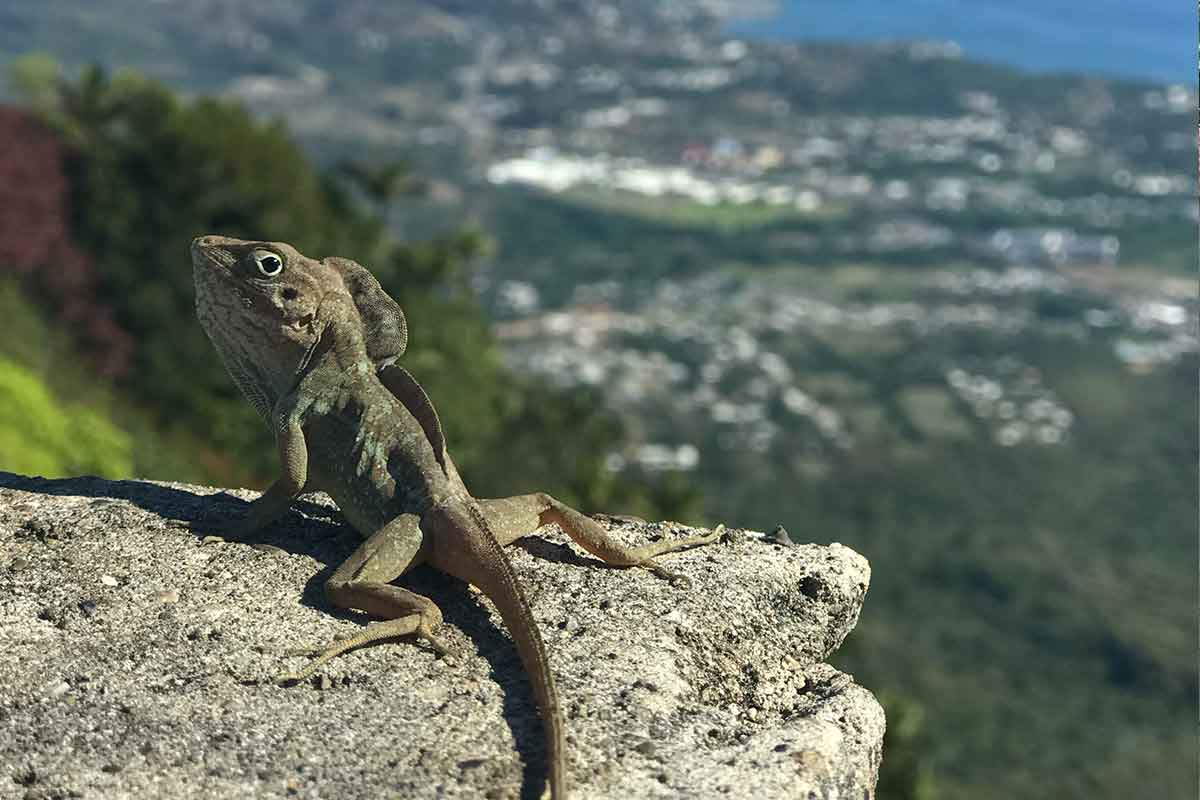
Given the Dominican Republic borders Haiti (which has its own on-going crisis at this time), you will need to be extra cautious if traveling close to the border between these two countries.
Lastly there has been a rise in the amount of Dengue and Chikungunya virus cases on the island , which are caused by being bitten by an infected mosquito. This means wearing a high DEET mosquito repellent is mandatory, and especially so if heading into more remote areas like within the rainforest.
Crime in the Dominican Republic
Crime can be an issue in parts of the Dominican Republic, in both the touristy and non-touristy areas.
Within the touristy areas it’s mainly pickpocketing (which is similar with other major moderately safe Caribbean cities like Havana ), which you can easily deter by not bringing valuables with you as well as dressing down.
Muggings do also happen (mostly at night or along more seedy streets), so if this happens to you then do not struggle and simply give over what they ask for .
Outside of the touristy areas you’ll want to keep your guard raised. There have been incidents of violent crime such as rapes and muggings targeted towards tourists who come out of there areas, so always use common sense when you are going off-grid (and preferably go with a trusted friend or organised tour).
Safety in the Dominican Republic during the day
Staying safe during the day in the Dominican Republic is much more simple than night, where your main concern is to avoid getting pickpocketed . This means keeping valuables (like your phone and wallet) in your front pockets, and to avoid walking in less touristy areas solo. See our favorite money belt for help with concealing your goods.
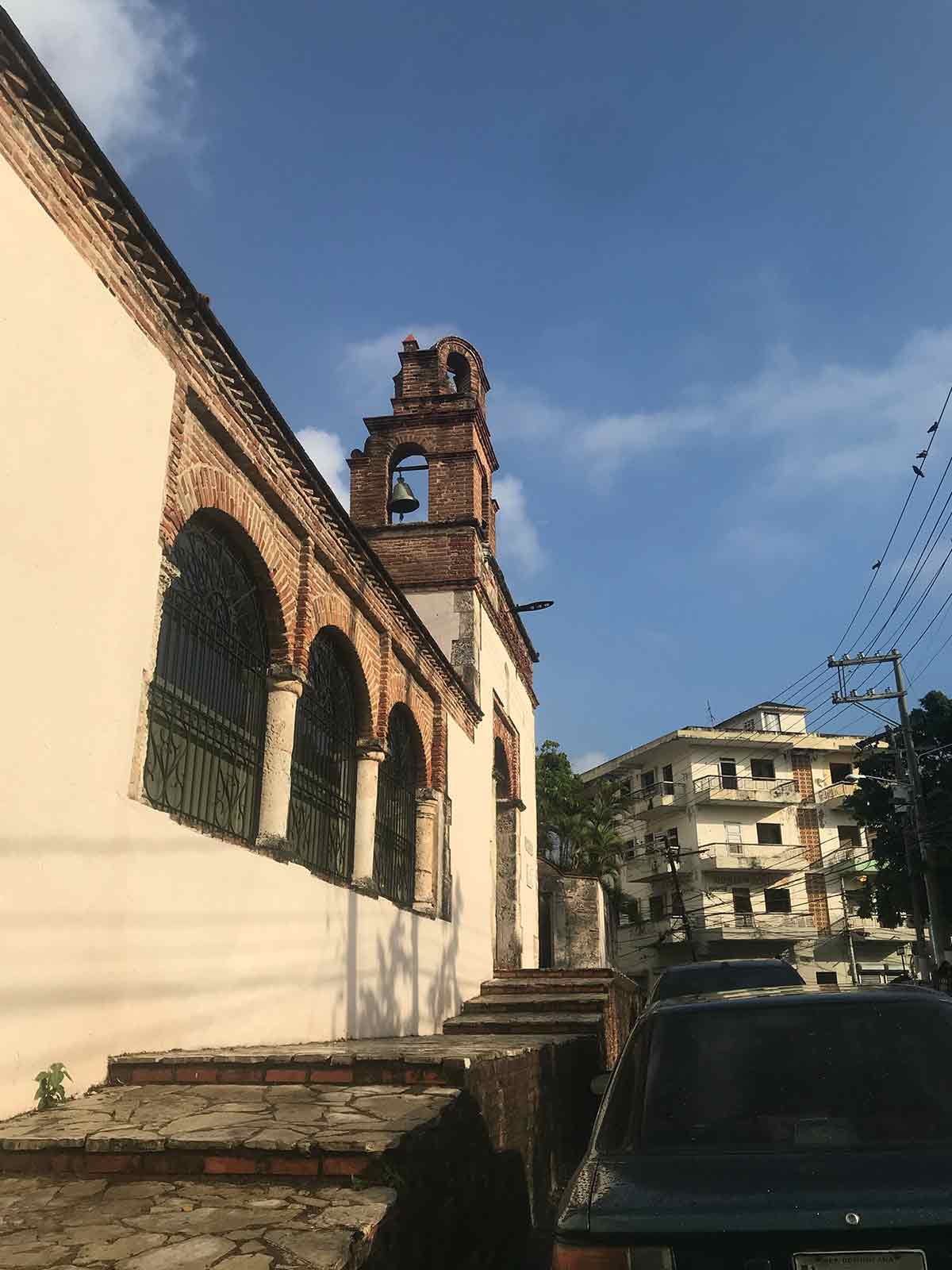
You’ll also want to be cautious when using transport too. There have been cases of criminals attempting to steal through open taxi windows, as well as muggings and theft by those who ride-by on motorcycles.
In general these risks are lower in more touristy areas like Punta Cana and the Zona Colonial in Santo Domingo, however these risks do certainly still exist.
The Dominican Republic Safety at Night
You’ll want to raise your guard up a notch (or three) when heading out at night in the Dominican Republic.
Making smart choices is the best way to avoid most problems that are reported at night in the Dominican Republic. This includes using Uber rather than hailing a random taxi on the street , as well as not getting blind drunk by yourself. Also be sure to avoid walking along quiet or unlit streets by yourself, given there is a risk of getting mugged.
There is also the risk of sexual violence here , which is mostly targeted towards females (although has been reported by both genders). Never accept drinks from a stranger, and aim to head out in a pair (or group) who can look after you if you’ve had a little too much.
Got travel insurance for the Dominican Republic?

7 Safety Tips for the Dominican Republic
Below we will list 7 of our top safety tips for when heading to the Dominican Republic.
Always Wear a Helmet when taking rides on local Motorbikes
Local Motorbike rides are one of the most popular (and cheapest) ways of getting around, and are more frequent in the north of the island. Whilst convenient, always make sure to wear a helmet when riding, given motorcycle-related accidents here are some of the highest recorded on the planet .
Always Be Drinking Plenty of Water
One of the biggest risks you’ll be facing when exploring the Dominican Republic is getting dehydrated. The Sun can be pretty hot here (almost brutal at times – especially in the cities), so you’ll always want to drink plenty. We recommend drinking up to at least 3 liters of water a day. Try carrying a Grayl filter bottle with you to save buying bottled water.
Stay in the Zona Colonial when in Santo Domingo
The capital is a really popular area to visit, especially given its where most travelers first arrive. The Zona Colonial is by far the safest area to stay in here, and also has the highest number of city attractions located along its streets. Not to mention, when it comes to affordable areas to stay in Santo Domingo this is one of our favorites, although you’ll still want to be careful at night and avoid walking into unknown areas alone.
Get Quality Travel Insurance before visiting the Dominican Republic
This is one of the easiest things you can do to stay safe (given it takes just a couple of clicks online). As well as allowing you to claim back any expenses in case something goes wrong, you’ll also have more peace of mind when traveling around the Dominican Republic knowing you are fully covered. We personally recommend booking with WorldNomads.
Avoid Exploring new (and less-touristy) Neighborhoods at Night
We love adventures and getting to know new barrios, however in the Dominican Republic we found that things can get pretty sketchy at night (especially on the outskirts of the Zona Colonial in Santo Domingo). We suggest exploring new areas in the daytime , unless going with a guide or local friend.
Lather up with Lots of Sunscreen
As already mentioned the sun is extremely hot here in the Dominican Republic. Whilst drinking plenty of water is necessary, there’s also a big risk of getting sunburnt too. Always be sure to lather up well with a high quality sunscreen , and to reapply multiple times in the day (especially if heading to the beach).
Leave Valuable Belongings back in your accommodation
Pickpocketing remains one of the biggest crimes in the Dominican Republic, and happens in both touristy and non-touristy areas. This means you’ll want to leave things like your passport and (large amounts of) cash locked away. Also when going to the beach, never leave things unattended if going for a swim in the sea .
The Dominican Republic Safety FAQ Guide
What makes the dominican republic so safe.
To be completely honest, the Dominican Republic is not safe in all areas equally. However those areas that are safest (such as Punta Cana, Las Terrenas, the Zona Colonial in Santo Domingo etc) are safe due to high levels of tourism. In most areas this has led to increased police presence, whilst in others the locals do their best to respect and help tourists.
Is the Dominican Republic safer than Mexico?
Overall we’ve found Mexico to be safer , although it does depend on where you go and what you are doing. This can be further backed-up by using data recorded by Numbeo for a more accurate picture. The Dominican Republic scored 39.03 out of 100 on the safety index (with 100 being the safest), whilst Mexico scored 46.16 out of 100.
Is it safe to drink the water in the Dominican Republic?
Never drink the tap water when in the Dominican Republic! It’s not treated, so there’s a high risk of getting ill with a bacterial or parasitic infection. This also means not accepting ice with your drink, unless you know for sure that it’s made from sealed bottles of water (which is what you should only drink from here).
How can I avoid getting sick in the Dominican Republic?
Is the dominican republic safe final words.
And that’s all for our guide on how to stay safe in the Dominican Republic.
As one of the world’s most popular beach destinations, the Dominican Republic is growing in popularity amongst backpackers looking to enjoy a slice of paradise on a budget.
We’ll also find all kinds of unorthodox attractions all over the island, as well as a very memorable and heated local culture .
Staying safe in the Dominican Republic is something you’ll want to keep in mind daily, given there are some risks. We’ve outlined the major threats whilst here, so it’s just a case of being sensible and revisiting this article in case you are unsure or need more reassurance.
In this guide, we’ve explored the current safety situation in the Dominican Republic , which includes whether it’s safe to visit, as well as any current travel advisories.
As well as looking at the best things to do in the Dominican Republic we’ve also included our FAQ which answers your most burning questions.
While you’re still here, be sure to read our Backpacking Dominican Republic Itinerary to learn more about what you can do when exploring this memorable Caribbean nation.
👉🏽 P.S. If you’ve found this guide helpful, buy us a coffee here to say thanks! Or, support us by downloading our South America Travel Bible to get our best content.
“ Dear traveler! Some links in this post contain affiliate links. Meaning, if you click through and make a purchase, book a hostel or sign up for a tour, we may earn a small commission at no additional cost to you . Your support means a lot and helps us to carry on traveling and maintaining the quality of this site for you.”
Similar Posts
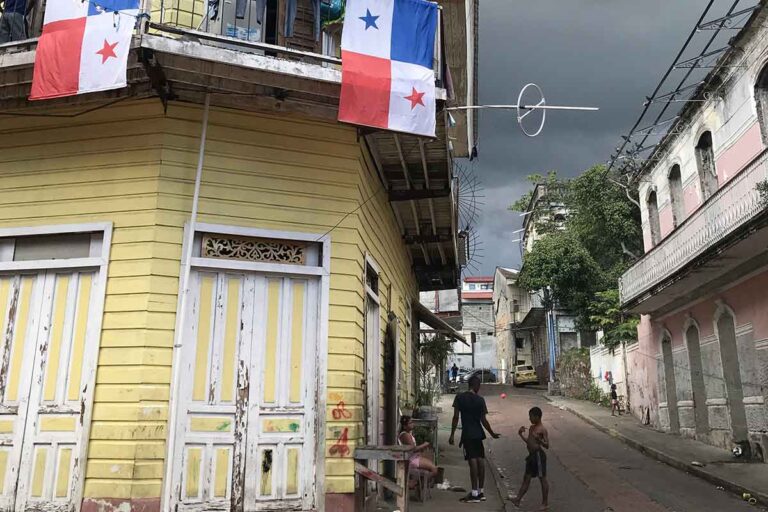
Is Panama City safe?
Is Panama City safe? Welcome to our Panama City safety guide. This giant city is one of the best connected in all of Latin America, however many travelers still wonder if it’s safe for a visit. Aside from discovering real Panamanian culture, old ruins and one of the most ingenious man-made creations of the 21st…
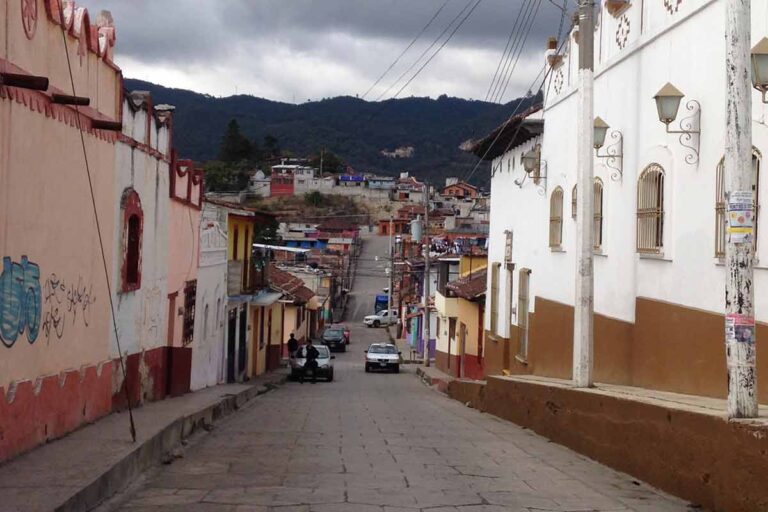
Is San Cristóbal de las Casas safe?
Welcome to our San Cristóbal de las Casas safety guide. Nestled up in the mountains of Chiapas, this town has become a staple among most travelers who backpack through Mexico. Here we can enjoy both a cooler climate, along with a more relaxed pace of life. San Cristóbal also offers a gateway into meeting the…
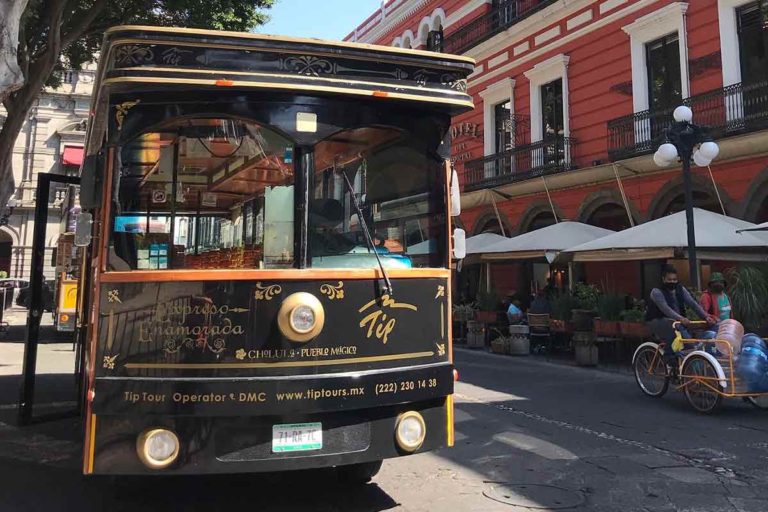
Is Puebla safe?
Is Puebla safe? Let’s find out below. Welcome to our Puebla City safety guide. Known for its colorful culture and friendly people, it’s a staple along any Mexican backpacking route. Here you’ll find many beautiful cathedrals, plazas and other architecture which are worth wandering around. There’s also the incredible ruins of Cholula too, which is…
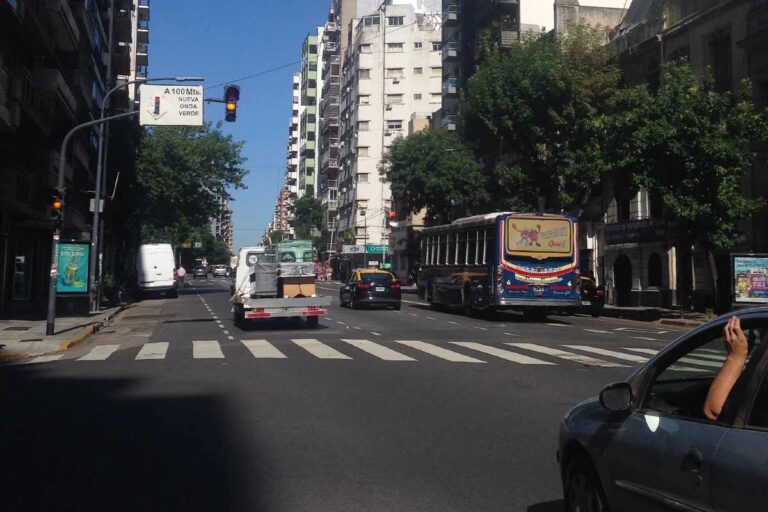
Is Buenos Aires Safe?
Welcome to our Buenos Aires safety guide. A bucket list city for most travelers heading to South America, the Argentinian capital has tonnes going for it. Here we can visit impressive sights such as the Recoleta Ceremony and the Teatro Colón, as well as try out a Tango dancing class (or watch the locals put…
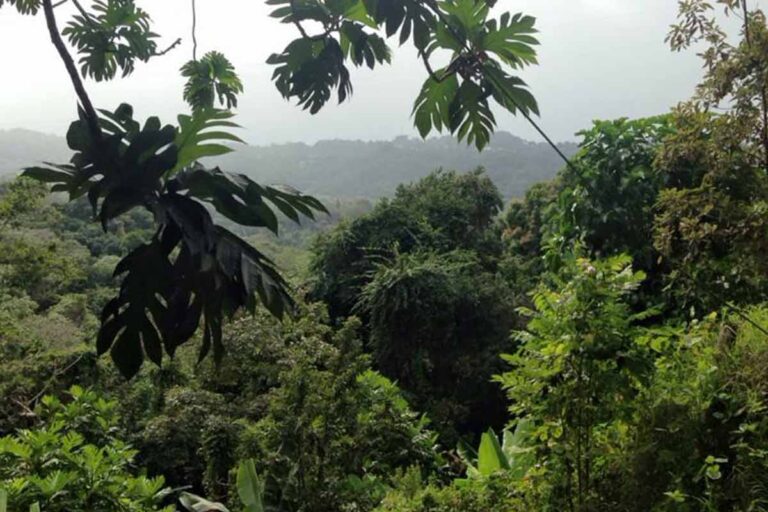
Maricao Jungle, Puerto Rico
Are you looking to visit a unique, yet untouched destination in Puerto Rico? Maricao Jungle is a rarely explored jungle in the west portion of the island, especially when compared with the more the touristy El Yunque near San Juan. However as you’ll see, The Maricao Jungle is full of incredible waterfalls, nature, colonial towns…
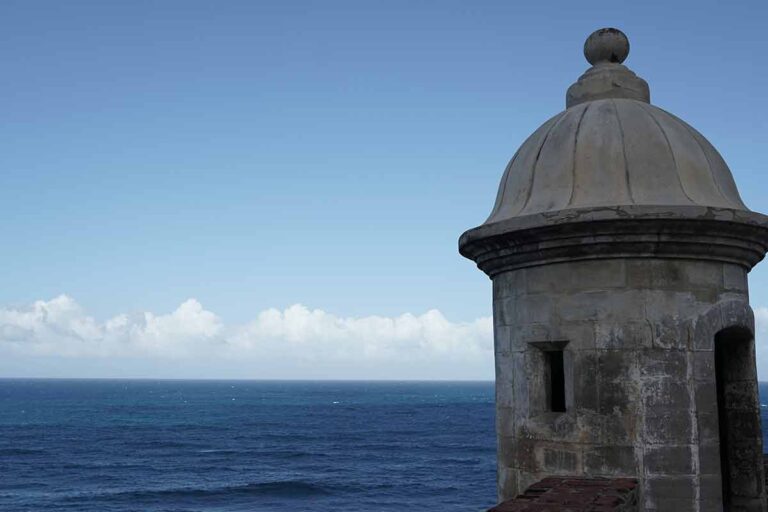
How to plan a trip to Puerto Rico on a budget
In this guide, we want to talk about visiting Puerto Rico on a budget. We’ll cover important things to know about budget travel to Puerto Rico including info on the language and currency, some safety tips as well best practices for getting in and around the island. How to plan a trip to Puerto Rico…
Advertisement
Supported by
Why Is Everyone Going to the Dominican Republic?
The country is a rare pandemic success story, with recent visitor numbers far surpassing those of most other Caribbean destinations. Easy entry rules are a draw, but some residents are uneasy.
- Share full article

By Heather Murphy
Some had come for the beach, some had come for the sun, others had picked it because, at the time, the Covid numbers seemed reasonable. Many had chosen it over resort destinations because getting there seemed easy. Still others liked the idea of not having to take a test to enter the country.
Together, they made up around 25 of the mostly American, Canadian and British guests enjoying the “Preferred Club” adults-only pool at Dreams Palm Beach Punta Cana on a recent weekend, even as Omicron drove coronavirus cases to record highs in the Dominican Republic.
The pool, which is roughly 10 lounge chairs wide, offered a peaceful retreat from the boisterous main pool, which snakes out from the buffet to the sandy stretch of coastline the resort shares with around 90 other all-inclusives.
In the Preferred area, a teacher from Chicago quietly read a book as new resort friends from Michigan and Ontario chatted about whether the woman hanging out on her room’s private terrace about three lounge chairs away, was quarantining. They were pretty certain she was, given that she had not left her room for days. This was a bummer. So, too, was the fact that at least three other Preferred guests had tested positive since they’d arrived.
Still, everyone seemed to be enjoying themselves.
They, along with all the other visitors who filled the majority of Punta Cana’s roughly 42,000 hotel rooms that January weekend, were part of what many consider a rare pandemic tourism success story. In December the Dominican Republic drew 700,000 visitors from abroad, more than it had attracted not only before the pandemic, but in any single month ever, according to the Ministry of Tourism. That pushed 2021 totals to nearly five million visitors, more than any other country in the Caribbean. In December, some financial analysts calculated that the country was having its best year economically in 30 years.
And Punta Cana isn’t the only getaway that’s booming in the Dominican Republic. Las Terrenas, a small seaside town that tends to attract a crowd that despises all-inclusives, has exploded in popularity during the pandemic.
The Dominican Republic’s visitor figures have to do, in part, with its unconventional strategy for gaining a competitive advantage. Unlike most Caribbean beach destinations, the country doesn’t require proof of vaccination, a Covid test or quarantine for most incoming travelers. Instead, authorities have chosen to manage Covid by pushing vaccination and mask wearing among those who interact with tourists. Nearly 100 percent of the 174,000 people who work in the tourism sector are vaccinated, according to the Ministry of Tourism. And though all-inclusive resorts require only a reservation to enter, many banks, government institutions and some shopping malls require proof of vaccination or a recent P.C.R. test.
“We knew it was a risk and we wanted to take it,” Jacqueline Mora, the deputy minister of tourism, said in a recent phone interview. The strategy has worked, she added, noting that the country estimates that it earned around $5.7 billion from tourism last year while maintaining a Covid death rate lower not only than Mexico, the other major beach destination to take a similarly lax approach to entry, but also many far more restrictive countries, including the United States.
Until recently, few pushed back. But as Omicron has driven Covid rates up by several hundred percent in the Dominican Republic (now categorized as Level 4, or “very high” risk, on the C.D.C.’s rating system), infecting many vaccinated people, long-simmering resentments about letting tourists get away with so much have surfaced among some doctors, politicians and resort employees.
In early January, more than a dozen lawmakers endorsed a proposal, supported by the president of the Colegio Médico, the Dominican Republic’s largest association of doctors, urging President Luis Abinader to require recent tests and proof of vaccination from visitors. The resolution calls the current policy “discriminatory,” given that “Dominican residents have to carry a vaccination card or recent negative P.C.R. test, while visitors don’t face the same requirements to enter Dominican territory.” On Jan. 31, the government is requiring banks, shopping centers, restaurants and other public transport to ask for proof that customers have been boosted. Airports and all-inclusive resorts will not be affected.
In Punta Cana, off with the masks
Australia had been their first pick, but the borders there were still closed to visitors, said Michael Rogers, 28, an event planner from London, who was celebrating a belated honeymoon in Punta Cana.
“We’re the guinea pigs for our family. If we don’t get it,” he said, referring to Omicron, “they’ll all go on holidays.”
Behind him, people were checking into Dreams Palm Beach Punta Cana. In 2021, nearly half of the foreign tourists who went to the Dominican Republic stayed in Punta Cana, at places like Dreams or the Iberostar Grand Bávaro on popular Playa Bávaro. Each one of the area’s 90 or so all-inclusive resorts is a bit different: Some are fratty party hubs, others are minimalist wonders. Some serve stale rolls. Some serve towers of fresh ceviche. Some cater to Americans, who made up nearly 60 percent of all visitors to the Dominican Republic last year. Others court Europeans, Latin Americans and Canadians who made up most of the other 40 percent.
The 500-room Dreams Palm Beach Punta Cana falls somewhere in the middle in terms of price and Tripadvisor ratings. On a recent Friday, staff members scanned visitors’ temperatures upon arrival and offered spritzes of hand sanitizer along with a glass of champagne. By check-in, many guests were no longer wearing their plane masks, but it was nearly impossible to find a staff member who was letting their nose peek out. This was the first hint that guests and employees follow different rules.
This generally works for the guests.
“We’ve been dealing with it for two years straight and sometimes you just want to throw in the towel and live a little,” said Cara McQueeney, 27, a mental health worker from Concord, N.H., as she and her boyfriend awaited their final beachside dinner. She was not trying to be careless; she’d been avoiding buffets. But she was glad that she didn’t have to wear a mask.
Dealing with Covid feels more reasonable in the Dominican Republic, said Gaelle Berthault, 45, later that weekend. She, her husband and 9-year-old son had moved to Santo Domingo from Brittany early in the pandemic because they were so fed up with the restrictions they faced at the time in France, she said while sitting on the porch of a turquoise cabana in Las Terrenas on the country’s northern coast. She resented having to carry a government-issued permission slip on her walks, which she had to limit to one a day.
“It felt like war time,” she said.
Since she found a new job in Santo Domingo, she feels freer. On the weekends, her family explores coastal towns like Las Terrenas, where her son might spend the morning splashing in the pool of a boutique hotel before venturing to a beach. In Santo Domingo, public buses sometimes require proof of vaccination, but she has never taken one.
A challenging time
The arrival of the virus had come at a terrible time for the Dominican Republic’s tourism industry. In March 2020, when the World Health Organization upgraded the epidemic to a pandemic, the country had just recovered from a different crisis. In 2019, 10 American tourists had died there, several mysteriously passing away in their sleep. Ultimately, the F.B.I. deemed that the incidents weren’t connected, but it was not good publicity. Visitor numbers fell by 9 percent, according to Ms. Mora. And then, just as they bounced back, the pandemic shuttered its borders.
For the 174,000 people who work directly in the tourism sector it was a challenging time. Though the government gave them money, a number of workers, including a maid, butler, server and concierge, calculated that they took home one quarter to one half of what they normally made.
When the country opened back up to tourists in July 2020, authorities briefly required visitors to show the results of a recent test. Then in August, President Abinader, who has a long history in the tourism industry, took office. The strategy began to revolve around making entry as easy as possible. Through last April, the country offered to cover the costs of medical care, lodging and flight changes, should guests fall sick with Covid. The airport did continue testing some visitors randomly, a policy that continues, according to the Ministry of Tourism.
To this day, most other Caribbean nations require proof of vaccination, test results and, in some cases, quarantine, and they also may restrict hotel bookings to 30 or 50 percent capacity to mitigate viral spread, according to Michael Lowery, the executive vice president of consumer business for Apple Leisure Group, which owns Dreams resorts and CheapCaribbean.com, a vacation booking platform used by millions. He said that the Dominican Republic has been one of the two most popular destinations for his company during the pandemic — behind Mexico — because travelers don’t want to deal with restrictions and because resorts fill up their rooms, keeping prices reasonable.
“They’ve done a good job of keeping their borders open and allowing 100 percent occupancy in all the resorts,” he said.
Large groups, even bigger than before, began to flock to the Dominican Republic, said TJ Murray, the owner of Punta Cana Tours , a booking site.
Couples who might not have considered the Dominican Republic previously for a destination wedding began to see it as a sure thing for guests traveling from across the world, said Jennifer Collado, the owner of a wedding and events agency based in Punta Cana.
The turnaround
By August 2021, about a year after the Dominican Republic reopened to tourism, you might have noticed something intriguing if you happened to be looking at Kayak.com’s flight trends. For more than a month, destinations in just one country consistently displayed green, meaning they had generated more search interest than they had two years earlier: the Dominican Republic.
September, November and December were good months for the country. Tourism numbers surpassed prepandemic levels, and coronavirus case counts stayed low, typically hovering between 100 and 300 daily. But then Omicron hit. On Jan. 12, a record 7,439 people tested positive in the Dominican Republic, far more than any other day during the pandemic. On Dec. 29, the country also reported eight Covid-related deaths, more than it had seen in a single day in months.
“The hospitals are full; children, old people, everyone, sick with Covid,” said Dr. Senén Caba, the president of the Colegio Médico.
He blamed the government’s lax entry policy for the suffering. Though people who work in the tourism sector may be largely young, healthy and vaccinated, they can still transmit the virus to family members and others. (Only 54 percent of the population overall is fully vaccinated.)
According to the tourism ministry the spike is not a reason to adjust the country’s approach.
“Omicron is everywhere,” and testing requirements offer countries little more than the illusion of security, Ms. Mora said. Willie Walsh, the director general of the International Air Transport Association, a trade organization representing nearly 300 airlines, echoed this argument in a recent statement.
Asked if interacting with potentially contagious visitors all day made him nervous, Maiken Mercedes, a server at Dreams Palm Beach Punta Cana, said, “What gives me fear is not the virus, it’s not making money for my family.” Other employees in the hospitality industry also expressed concerns that more restrictions would mean fewer guests.
But there has to be a way to encourage responsible tourism, said Ivan Lorenzo, a senator for the Dominican province of Elías Piña, which shares a border with Haiti.
“We cannot rationalize the human losses with what we generate economically,” he said.
Neither he nor several hospitality workers interviewed were convinced that requiring tests would derail the country’s growth. In fact, some found the suggestion that the lax policy is what’s drawing people to the Dominican Republic insulting.
The dreaded end-of-vacation test
No matter how much they try not to think about the coronavirus, at the end of the day, visitors have to think about it because the United States, Canada and many other countries require a test to re-enter.
For Kelly Lynn Gasper, 57, a behavioral health nurse from Oakley, Mich., the possibility was particularly nerve-wracking because early in her one-week visit with her 18-year-old daughter to Punta Cana, she’d started to feel like she was coming down with something. She took two rapid tests she’d brought and tested positive twice, she said.
Ms. Gasper was conflicted about how to proceed, but ultimately opted not to spend her whole vacation in her room, instead upping her mask wearing and avoiding indoor spaces. As her daughter, Caitlyn Gasper, who’d already had Omicron back home, pointed out, other people were probably positive around her, but didn’t know it, so why should she be penalized for testing positive?
Much to her relief, Ms. Gasper tested negative that morning at the resort clinic. The results had come so fast — within a couple of minutes, instead of the 15 that is more typical — she had wondered about their accuracy.
Kris Milavec, 59, of Concord Township, Ohio, did not share Ms. Gasper’s skepticism, because earlier that day her husband and one other member of her group of nearly 20 had quickly tested positive and were now stuck in their rooms.
As to whether it was worth it, given that her husband, an anesthesiologist who was expected back at the hospital, was apparently stuck abroad, Ms. Milavec paused.
“I don’t think it was worth it,” she said as the rest of the group posed for poolside photos in their matching white outfits.
Enzo Conte, the owner of a software company in Quebec, would also prefer not to get Omicron. But if he’s going to get it, he said, it might as well be while he’s staying at a beachside villa in the Dominican Republic. Since early December, he has been alternately vacationing and working remotely from Las Terrenas.
Should he test positive, he said, “I’ll just stay a little longer.”
Hogla Enecia Pérez contributed research from Santo Domingo.
Follow New York Times Travel on Instagram , Twitter and Facebook . And sign up for our weekly Travel Dispatch newsletter to receive expert tips on traveling smarter and inspiration for your next vacation. Dreaming up a future getaway or just armchair traveling? Check out our 52 Places for a Changed World for 2022.
Heather Murphy is a reporter on the Travel desk. She welcomes tips, questions and complaints about traveling during the pandemic. More about Heather Murphy
- Search Please fill out this field.
- Manage Your Subscription
- Give a Gift Subscription
- Newsletters
- Sweepstakes
State Department Issues Travel Warning for Popular Caribbean Country Due to Safety Concerns
Travelers are advised to exercise increased caution.
:max_bytes(150000):strip_icc():format(webp)/alison-fox-author-pic-15f25761041b477aaf424ceca6618580.jpg)
The Department of State is warning travelers who are going to the Dominican Republic to exercise increased caution due to crime and safety concerns.
The popular Caribbean country was placed under a Level 2 warning out of a total of four, according to the State Department . The department regularly updates and reissues travel advisories for countries all around the globe.
“Violent crime, including armed robbery, homicide and sexual assault is a concern throughout the Dominican Republic ,” the State Department wrote in its warning. “The wide availability of weapons, the use and trade of illicit drugs, and a weak criminal justice system contribute to the high level of criminality on the broader scale.”
Massimo Borchi/Atlantide Phototravel/Getty Images
However, the department did note there was a lower risk in popular resort areas due to “the development of a professional tourist police corps, institution of a 911 system in many parts of the country, and a concentration of resources in resort areas.” These areas tend to therefore “be better policed than urban areas like Santo Domingo.”
Travelers who do go to the Dominican Republic should be aware of their surroundings, never physically resist any robbery attempt, and avoid displaying signs of wealth (like wearing expensive watches or jewelry).
Travelers can also enroll in the State Department’s Smart Traveler Enrollment Program to receive alerts “and make it easier to locate you in an emergency.”
The State Department issues travel advisories and travel alerts to “help you assess for yourself the risks of international travel and what steps to take to ensure your safety when you decide to go abroad.” These advisories can be issued for an entire country or a specific area of the country and can vary by region based on the situation.
Recently, the State Department issued advisories for several popular vacation destinations, including certain areas of Mexico , Colombia, and Jamaica .
Related Articles
Cookies on GOV.UK
We use some essential cookies to make this website work.
We’d like to set additional cookies to understand how you use GOV.UK, remember your settings and improve government services.
We also use cookies set by other sites to help us deliver content from their services.
You have accepted additional cookies. You can change your cookie settings at any time.
You have rejected additional cookies. You can change your cookie settings at any time.
- Passports, travel and living abroad
- Travel abroad
- Foreign travel advice
Dominican Republic
Warnings and insurance.
The Foreign, Commonwealth & Development Office ( FCDO ) provides advice about risks of travel to help British nationals make informed decisions. Find out more about FCDO travel advice .
Before you travel
No travel can be guaranteed safe. Read all the advice in this guide and any specific travel advice that applies to you:
- women travellers
- disabled travellers
- LGBT+ travellers
Follow and contact FCDO travel on Twitter , Facebook and Instagram . You can also sign up to get email notifications when this advice is updated.
Travel insurance
If you choose to travel, research your destinations and get appropriate travel insurance . Insurance should cover your itinerary, planned activities and expenses in an emergency.
Related content
Is this page useful.
- Yes this page is useful
- No this page is not useful
Help us improve GOV.UK
Don’t include personal or financial information like your National Insurance number or credit card details.
To help us improve GOV.UK, we’d like to know more about your visit today. We’ll send you a link to a feedback form. It will take only 2 minutes to fill in. Don’t worry we won’t send you spam or share your email address with anyone.
- English (EN)
- Español (ES)
- Português (BR)
Is Punta Cana Safe? Crime Rates & Safety Report
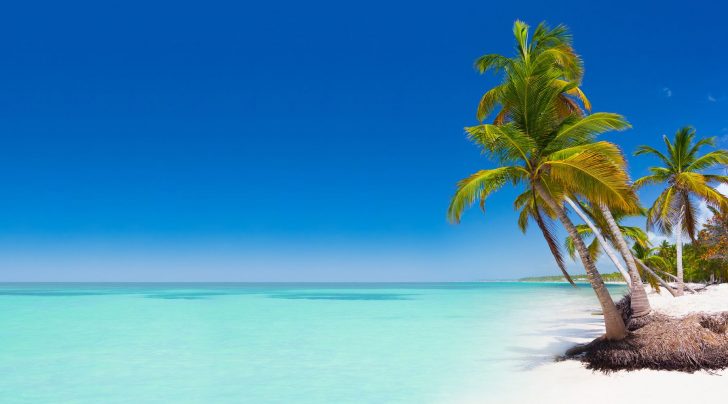
Dominican Republic : Safety by City
- Las Terrenas
- Playa Rincon
- Santo Domingo
Punta Cana refers to the area on the eastern tip of the Dominican Republic .
With its stunning beaches and all-inclusive resorts, this Caribbean destination attracts visitors from around the world.
The safety of the tourists, as well as its residents, is a major concern for hotels which are very well protected.
Major resort areas are Bávaro and Uvero Alto with a perfect beach area.
The airport which can be found in the area makes access easy.
The peak season in Punta Cana lasts from December to April when the prices of travel and accommodation extremely increase.
- Warnings & Dangers in Punta Cana
OVERALL RISK: MEDIUM
The Dominican Republic’s economy is based on tourism, so safety is a major concern for hotel owners. That is why hotels and resorts are very well guarded, as well as the beach area. Some health hazards like sunburns and mosquito-borne diseases are the major risks when in Punta Cana. Females should never travel alone there.
TRANSPORT & TAXIS RISK: MEDIUM
When you go on a tour, make sure you have not left your luggage on the tour bus, even if the driver convinces you that it is safe to leave it there. All taxis have standard rates, but it is better to determine the price in advance. The public transportation in the Dominican Republic is characterized by irregular bus schedules, crowded and unsafe vehicles. In case you want to drive, be aware of the fact that the drivers weave from lane to lane and rarely signal. Drink driving is common which leads to numerous road accidents.
PICKPOCKETS RISK: MEDIUM
It can be said that chances for pickpocket-related risk in the Dominican Republic are medium since there might be thieves in public transport and crowds. Within your resort, you can feel safe but when you decide to go outside the resort area, you should keep an eye on your belongings and be aware of your surroundings.
NATURAL DISASTERS RISK: MEDIUM
The Dominican Republic is prone to many natural hazards, such as hurricanes which happen from June to November. Earthquakes are also frequent. In case of an earthquake, the Dominican Government authorities, fire-fighters, and police will provide help to you, so refer to them. You should be aware of wild animals and protect yourself against infectious mosquitoes with the Zika Virus.
MUGGING RISK: MEDIUM
The risks of being seriously assaulted, like being mugged or kidnapped, in the Dominican Republic are medium, and you should not be worried as long as you avoid visiting dangerous zones.
TERRORISM RISK: LOW
When it comes to terrorism risk, you can relax. The Dominican Republic is a very safe country. However, terrorist risks cannot be predicted or ruled out, since the global threat exists.
SCAMS RISK: MEDIUM
The Dominican Republic is a touristic place and tourists attract the scammers. They will try to fool you to get money from you, so pay attention to the strange-looking people around ATMs, groups of teenagers and people who want to help you with your luggage.
WOMEN TRAVELERS RISK: MEDIUM
Women should never travel to Punta Cana alone since there is a great risk of being assaulted. There are dangerous neighborhoods that need to be avoided.
- So... How Safe Is Punta Cana Really?
The Dominican Republic is a desirable destination for many tourists around the globe and many people spend their dream journey without any issues.
However, criminal acts, like bag-snatching and pick-pocketing and even some violent crime, might destroy your trip and spoil the impression.
There have been reports that foreigners have been pickpocketed during the daytime while walking in residential districts, so take particular care in remote areas, especially at night.
A very little precaution will lower the risks of being assaulted.
- How Does Punta Cana Compare?
- Useful Information
If you need information about the entry requirements to the Dominican Republic, you need to contact the embassy, high commission or consulate of the country. All visitors need a tourist card which can be obtained from the Embassy of the Dominican Republic or at the airport when you arrive, to enter the Dominican Republic. The tourist card is valid for 30 days. It can be extended by paying for an extension when you leave the country.
The official currency of the Dominican Republic is the Dominican peso. You can easily exchange money at banks or official exchange offices and do not try to exchange it on the street no matter how better the exchange rate is. It is advised to exchange only small amounts of money at a time to avoid any inconveniences. Be very watchful when withdrawing cash at an ATM. There might be some places that accept US dollars, Euros, Canadian dollars, British pounds, but it is a bit cheaper to pay in Dominican pesos.
The tropical climate is the constant weather and an average temperature of 26°C makes Punta Cana a perfect destination all year round. The hottest season is from April to November, while from December to March evening temperatures are around 20°C. This is the area where very little rainfalls.
Punta Cana International Airport offers flights to and from many large cities in the world. It has numerous facilities as well as air conditioning. It is one of the busiest and best-connected airports in the region. Another airport that can be used as an alternative when coming to Punta Cana is the Aeropuerto Internacional de Las Américas, located in Santo Domingo.
Travel Insurance
Since there are risks of wild animals and mosquitoes with the Zika virus, travel insurance is a must when coming to the Dominican Republic. Do not risk, because medical issues might happen to you here. The crime rate is also high, so make sure that your insurance covers luggage theft as well.
Punta Cana Weather Averages (Temperatures)
- Average High/Low Temperature
Dominican Republic - Safety by City
- Where to Next?
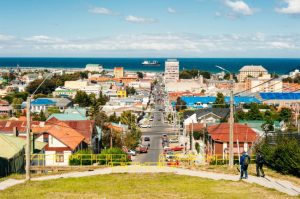
17 Reviews on Punta Cana
Is this true.
Is the review in this page correct about the place? Would you recommend as a couple with 2 kids to go visit there for a vacation? Thanks!
Hello, Thanks for your words. Was concerned about safety, granddaughter wanted to go to Nickelodeon. Only if there is one somewhere else.
Why somewhere else? GO. It is one of the safest places in LatinAmerica. Jesus, I hear things like this here in NY from people that live in freaking NYC. NYC is 50 times more dangerous, and people walk carelessly there. Punta Cana, on the other hand, is full of private businesses with private housing, with private security on top of public security where anything bad that could happen would be bad PR. GO. If you don’t believe me, just pull up Punta Cana’s statistics and compare them to any city you want.
Yes of course my parents and families are there right now on vacation and my cousin went there for his Honeymoon, I’m Guyanese Indian from Guyana my ex is from Dominica Republic, next year we coming to visit again 👍😀
Me and my family stayed for about a week and went around the city we saw nothing happen only a little bit of rain in the morning but that is it
Never Again
When I was there in 2005 it was very anti American. Also our travel agent told us last year she booked many to Punta Cana and they all got food poisoning. She won’t book there anymore.
I won’t go back.
Just returned Wednesday from a family wedding week in Punta Cana. We had a 3 mo. old, an 18 mo old, 3 year old and 7 year old in the group.
To my knowledge none of the children had health problems. Two adults (including groom) had intestinal problems that lasted only 24 hrs and 2 older females (including myself) developed severe rash, itching, burning, raw skin patches, low grade fevers, higher blood pressure and needed to seek Urgent Care when returned to US.
The symptoms began on the 3 rd day there for each of us (different days) and got worse each day. We were put on strong anitibiotics, prednezone, Prescription strentgh allergy meds and over the counter and prescription ointment for sores, open sores.
The rash was the worst anywhere your sweat glands were most active.
I did not go into the ocean until the 3rd day, and the reddish seaweed with the little bulbs on the end were everywhere.
Not sure if that was the problem. To date no one else in the party of 30+ has reported problems. Never went off resort property.
I had a similar issue in another location that was near the ocean. I was told that I like came into contact with a contaminated surface and given the area of the rash, the bacteria was likely within the sheets. I can’t remember what it was called but it cleared up after a few days. Punta Cana was fine for me though, I recently got back and had no issues with a rash whilst staying.
I am to the party every day.
Fantastic vacay destination
I had a wonderful experience in Punta Cana.
I rented an Airbnb about 200 yards from the water. The people were friendly and I felt safe the whole time I was there. The people are so friendly and helpful.
I’m not sure what they base their information on, but the description above is inaccurate. I spent 7 days there and would go back in a heartbeat.
I wouldn’t stay at a resort, but a private home near the beach is wonderful. I never got sick, didn’t drink the water and ate at the restaurants on the water.
i’ve been to punta cana three times and stayed at different resorts and felt safe (bavaro) there were armed guards at the entry points and leaving points.i spent most of my time within the resort,the food was good,the staff were friendly,the rooms were kept clean and had a small frig that had liquor and soft drinks i took a boat trip to an area where i was able to snorkle and was able to see a shark and sting ray in a cage.the staff aboard the boat were alert and attentive to those of us that snorkled. i’m going back very soon.overall rating 4.5.
VERY GOOD, also, Not Dangerous at all
There is no place safer than Punta Cana in the Dominican Republic. I am a Data Scientist, dominican-american. I visit Punta Cana almost once a year. Even if you wander off from your hotel/resort, you will be fine. Why?
1-Because the area has 414 hotels/resorts: An example would be Punta Cana Group’s Foundation, this foundation not only makes sure there is private security starting from far away from anything they own, they also create schools, employ, and pay college tuition for thousands of kids around the edges of Punta Cana, that might not have much money. Keep in mind: this is only one hotel group, there are 414 hotels/resorts in Punta Cana protecting their interests.
2-Because the area has residentials of people that are high middle class up to the wealthiest in the country: If you wander off from your resort only miles out, say 30 minutes out, the security is pretty much the same. Yes, the streets are “public”, but they are also kind of not. You see, Punta Cana City, or Punta Cana “Downtown”, or any of those names they’ve come up with, is completely full of private residences. Most of these residences are on planned communities that maybe only 8% of all Dominicans could ever afford to live in. Because of this, each little community has private security. And each of these private securities are at least 15 armed private guards going around, doing turns, stopping people.
Those 2 points I made, and I have not yet mentioned something important: the province’s police. There is a consortium of companies that PAY the Police to literally have way more resources than any other Police Station in the country. Do you have any idea what would happen if a half-rich or rich kid from Punta Cana’s families suddenly gets hurt, or more intense, disappears? Or maybe, do you have any idea of what would happen if the directives of all these tourism companies start losing money because of bad PR because tourists in their city are getting robbed? Ho ho ho, that is not happening. To put it simply, these robbers would be *hunted*, the same way you hunt a deer. Here are the statistics of the police http://www.oscrd.gob.do/ . You won’t find Punta Cana on the statistics, because it is so low.
So, is it safe? It is definitely safer than NY, where I life, and I live in Scarsdale, which is supposed to be one of the safest neighborhoods near the city.
Now, I’d like to make a comment on something grammyS said, that she/he had to wait until going to the US to go to urgent care. I’d like to start saying, if it is urgent, why didn’t you visit a hospital in Punta Cana? Next is, was it because you think dominican Doctors are bad? Because to that I’d say, most Dominican Doctors graduate college in DR and go to their Residency (specialty) training in the US. Why? Because of how incredibly competitive it is to match in DR (not a lot of open seats every year for ANY specialty). So, you basically have a US trained Doctor in PC, specially in PC, where the Doctors are kids that come from rich families, that could afford to send their kid to study medicine in the Capital or in Santiago (because there are no Med Schools in Punta Cana), and that after that had to sent their kids to the US to do their residency program after passing the USMLE Step 1. Then, they go back to DR. I know this because I brother graduated Med School, and is now doing his Urology residency here. It was surprising to me, that I went out to eat with him and his friends, and ALL his friends were the same one he studied medicine with in DR. They explained it was EASIER to get into a residency program in the US than to try your luck in DRs matching system because of the lack of seats. Also, a cousin of mine (lives in Florida), had a son. His son has these allergies, and Pediatrics in Florida didn’t want to give him medicine. Not because they didn’t really want to, but because it was not completely necessary, and specialists in the US are afraid of lawsuits like crazy, to the point of practicing defensive medicine. So my cousing simply took a flight to our country, and visited a Pediatrics specialist. Boom, in 1 days the kid stopped coughing. The Ped told my cousin that those same meds are 13 times more expensive in the US, if a US Ped would have the balls to give them to a kid (and he knows because the Ped he visited in DR did his specialty in: Florida). LMAO.
Anyways, guys, are you sick? Just go to the Doc and stop the prejudice. Do you want to see something more than your resort? Go, nothing’s gonna happen to you, SPECIALLY in Punta Cana.
I love your review and reply! I am going with a group of 14 adults from Western Pennsylvania. The group I’m traveling with is much more “bougie” than I. I like to get out of the compound (resort) and wonder into the local communities while on vacation. Everyone is worried I’m going to wonder off and become a “statistic”, or a victim of a crime. Literally my boss said the only reason they’re coming is to keep an eye on me 😂
I’ll be sure to show them your review! I don’t like to travel to stay by the pool the entire time! I want to experience the culture!!
Hi would you say its safe for a woman to travel there on her own
Hello Michaela yeah it is safe for women to travel here on her own 🙂
Very nice area
Coco Bongo Punta Cana, Macao beach and the Caroles golf course are just 3 great places to visit and go to while here. There are plenty more, plus nice hotels and restaurants with great food. Try the La Yola restaurant, you’ll thank me later ;)!
Heavenly beautiful
We’ve vacationed here five times already, it’s that good! I’m the type that won’t come back to a location unless I liked everything and Punta Cana checked all the boxes, from the locals to the staff and the myriad of resorts and hotels.
We generally tip very well and if your budget allows, please do so, they will be more than happy to reward you with even better service and tips on how to get the most out of your trip. The first time we got there we didn’t leave the resort and to be honest, we didn’t feel like we missed on something. We read, had daily massages, sunbathed like there was no tomorrow and drank all the cocktails we wanted.
Downtown Punta Cana you will find a lot of stores that sell anything from delicacies to memorabilia.
We booked our trip to surrounding areas online before, experience taught me that hotel staff tend to recommend tour operators that they get along with/know better which means you don’t always get the best deal.
The Philippines, for example, is not the best place to leave your resort and explore as you might 1. Get in trouble 2. End up losing precious time as there’s not very much to see around, depending where you’re staying.
Just to touch on a hot subject: several years ago there were some incidents regarding some tourist deaths but nothing was confirmed. No location is as bad as the media reports it, things are usually blown out of proportion.
Punta Cana is a resort town that I would label both as fun and entertaining. It’s a great destination regardless if you’re traveling solo or with your family. If this is your first time traveling there I would start with the Hard Rock Hotel & Casino complex, their services are off the charts.
Share Your Experience Cancel reply
Your Review
Title of your review
Article Contents
- Punta Cana : Safety by City
- Overall Risk
- Transport & Taxis Risk
- Pickpockets Risk
- Natural Disasters Risk
- Mugging Risk
- Terrorism Risk
- Women Travelers Risk
- Weather Averages (Temperatures)
- User Reviews
- Share Your Experience
Popular Destinations

Safety Index
Recent reviews & comments.
- Carlo Jones on Snellville
- Erwin Cole on Kalamazoo
- Anthony Jackson on Kalamazoo
- Toby York on Kalamazoo
- Jackie Hughes on Council Grove
Popular US States
- Pennsylvania

HOME ABOUT US ADVERTISING CONTACT
Last update on May 7, 2024, 4:45 pm
Tourism May 3, 2024 | 2:47 pm
US Consul affirms: Dominican Republic is a safe tourist destination
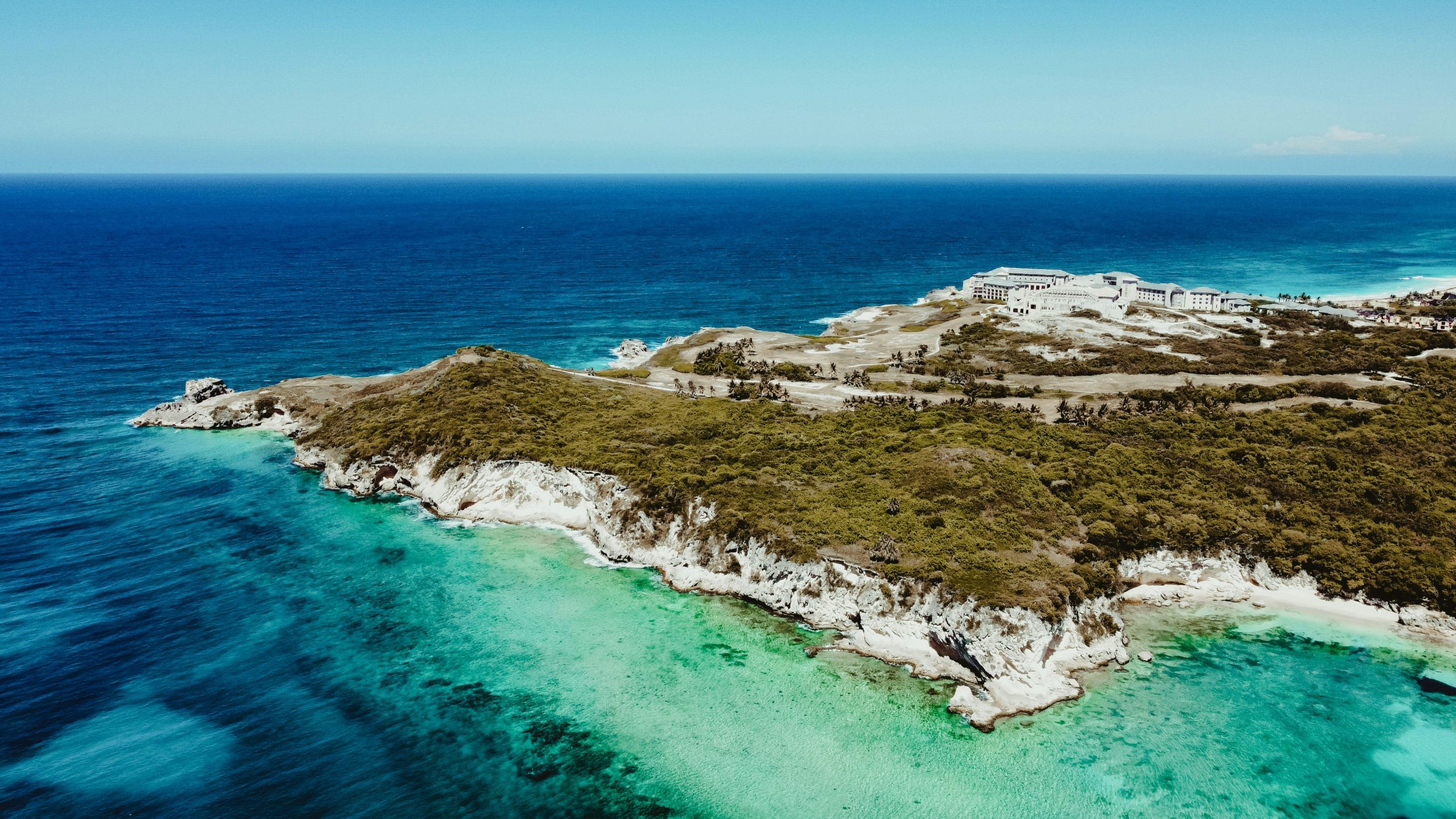
Santo Domingo.- Yomaris Macdonald, the acting Consul General of the United States in the Dominican Republic, emphasized that the DR stands out as a highly secure tourist destination, attributing the recent surge in US visitors to the country’s safety record.
Highlighting the strong partnership between the DR and the United States, Macdonald underscored collaborative efforts aimed at enhancing security in tourist hotspots. He mentioned conducting a series of training sessions in Punta Cana, Santiago, Las Terrenas, and other areas in conjunction with the Tourist Police (Politur) and the prosecutor’s office to ensure the safety of US citizens visiting the Dominican Republic.
In February, an agreement was signed among the United States Consulate, Politur, and the Hotel and Tourism Association of the Dominican Republic (Asonahores) to reinforce relations and establish a protocol for managing incidents involving US citizens, alongside facilitating prompt information exchange about US tourists in the country.
Macdonald stressed the significance of such measures, particularly as more Americans are venturing beyond their hotels to explore the country independently, often encountering challenges such as medical emergencies, petty theft, or scams, notably through dating apps.
For assistance, offices have been set up in Puerto Plata and Punta Cana to aid Americans, though they do not offer consular services, only emergency assistance.
It is noteworthy that the United States ranks as the top source of tourists for the Dominican Republic, with over four million American tourists visiting each year. In 2023, Americans accounted for 47% of non-resident tourists, marking a 22% growth. In March 2024 alone, the United States contributed 49% of tourists.
Like any destination…anyone that seeks out trouble is sure to find it. I travel here often and have never had an issue. I have found the people to warm and welcoming. Most impressive is their sincere reverence for their seniors. This is an example for the world.
May 5, 2024 | 9:36 am
287 people arrested in Los Haitises for environmental crimes

April 30, 2024 | 10:04 am
SeNaSa hires more than 1,500 doctors

April 26, 2024 | 9:23 am
Pro Consumidor clears rice brands of harmful metals

April 22, 2024 | 1:21 pm
Ney Arias Lora Hospital and CMD appeal ruling

April 15, 2024 | 8:40 am
Cyber attack exposes Covid-19 vaccination records in Dominican Republic

April 9, 2024 | 3:12 pm
Dominican Republic moves to implement neonatal screening

Expats' Corner

Business & Pleasure

- ADVERTISING
- Privacy Policies
- Cookies Policy
DominicanToday.com - The Dominican Republic News Source in English
Av. Abraham Lincoln N° 452 Local 220B, Plaza La Francesa, Piantini, Santo Domingo
Tel. (809) 334-6386

9 Things to Know Before Visiting Punta Cana
W ith over 1,000 miles of coastline and some of the prettiest beaches in North America, the Dominican Republic is a popular beach destination. With convenient flights from the U.S. and Canada, Punta Cana is one of the most popular areas in the Dominican Republic. Most travelers head to an all-inclusive resorts during their trip to DR, making for an easy beachy getaway. However, there are several things to keep in mind. Here are the top things to know before visiting Punta Cana.
- Punta Cana International Airport PUJ is one of the largest airports in the Caribbean with service in-between 26 international destinations.
- Cabs can be expensive so arrange for a transfer before arriving
- Spanish isn’t necessary, though it’s nice to use some common phases.
- Changing money isn’t necessary however cash for tips is necessary.
- There are several resort areas in Punta Cana, like Bavaro, Cap Cana and La Romana.
- DR boasts 200 Beaches
- Nude Sunbathing Isn’t a Thing in DR
- The Dominican Republic features a National Park, perfect for an all-day excursion.
- Bottled Water is a Must in DR
How to Get to the Dominican Republic
The Dominican Republic is the second-largest island in the Caribbean. It offers several international airports. After several trip to DR over the years, I am sharing the Things to Know Before Visiting Punta Cana.
The Punta Cana International Airport
With service from several international carriers, including direct flights from Britain, France and South America. U.S. travelers will find American Airlines, United Airlines, Delta Airlines, Southwest Airlines, Jet Blue Airlines, Spirit Airlines and Frontier Airlines.
WiFi is available, and restrooms are located near the immigration line.
A valid passport with more than six months before expiration is required for your trip is required. e aren’t required to enter the country. A 30-day tourist visa will be stamped into your passport upon entry. The Dominican Republic Entry fee is included in your flight.
The Dominican Republic requires U.S. Passengers to fill out an online Immigration form before they arrive. Before my last trip in December 2023, my airline sent me a link (Delta Airlines).
On departure, U.S. residents can opt for the automated immigration lines. You will just scan your passport and pass through a gate.
The Punta Cana Airport features enhanced security measures with pat-downs. A TSA pre-check line isn’t available.
The departure area is fully air-conditioned and features a duty-free shop and another shop specializing in Dominican Republic products, like rum and cigars.
Find American fast food in the departures area, like Wendy’s, Sbarro, Nathan’s, Cinnabon and Baskin-Robbins. Also find a bar for pre-departure cocktails.
Find a small play structure for younger kids. The Punta Cana International Airport also features a nursing room.
Other International Airports in The Dominican Republic
Santo Domingo International Airport (SDQ) –With service from the U.S. on American Airlines, United Airlines, Delta Airlines, Jet Blue Airlines and Spirit Airlines.
Santiago International Airport (STI) –With service from the U.S. on American Airlines, United Airlines, Jet Blue Airlines and Spirit Airlines.
Puerto Plata International Airport (POP) –With service from the U.S. on American Airlines, United Airlines and Jet Blue Airlines.
Resort Review: Hyatt Zilara Cap Cana
Airport transfers.
When leaving the arrivals hall at the Punta Cana International Airport, a line of cab drivers will greet you. I recommend arranging transportation with your resort or hotel before arriving. This is one of the Things to Know Before Visiting Punta Cana.
There are several transportation and tour counters in the area. I usually check in with my transportation company to find my driver. Often they are waiting a short distance from the airport and pull up after you arrive.
Most cars in the Dominican Republic are air-conditioned.
What Language is Used in the Dominican Republic
The Dominicans speak Spanish though most understand and speak some English. Knowing some basic Spanish is helpful, especially the basics.
Hola = Hello
Buenos Días = Good Morning
Buenos Noches = Good Night
Muchas Gracias = Thank you very much
What Money is Used in the Dominican Republic
The official currency of the Dominican Republic is the Dominican Peso (RD$). Though the U.S. Dollar is widely accepted. This is one of the Things to Know Before Visiting Punta Cana.
Change will most likely be given in U.S. dollars. For those who want local currency, ATMs are located in hotel lobbies as well as the airport.
Credit Cards are widely accepted throughout the Dominican Republic. It’s advised to use a credit card for large purchases like lodging. Though use cash for souvenirs and small purchases. Tips are accepted and appreciated in DR from spa services to daily maid service.
Phone Service in the Dominican Republic
Since I travel internationally, I have a global plan through my U.S. carrier. When I land I just switch over to the local service provider. I just use my data to check email and messages. The provider I used throughout my trip to DR was Altice.
Most all-inclusive resorts offer extensive WiFi for their guests. Most of the time this service is included. This is one of the top things to Know Before Visiting Punta Cana.
Where to Stay in Punta Cana
Most resorts in the Punta Cana area are all-inclusive resorts. Travelers will find everything from luxurious and laid-back adult all-inclusives to family resorts with waterparks.
Some resorts are divided into an adults-only side with an adjoining family side, each with separate restaurants, pools and gathering places. Other resorts offer buildings dedicated to adults or families.
With several different resort areas in Punta Cana, visitors will choose from laid-back La Romana to buzzy Bavaro. Cap Cana boasts Juanilla Beach, one of the most beautiful in the Caribbean.
Near Punta Cana, Cap Cana boasts wide white sand beaches with lots of palm trees. A resort community, Cap Cana features the Hyatt Zilara Cap Cana and the Hyatt Ziva Cap Cana. Both of these properties opened in 2021 and offer a luxurious all-inclusive resort experience.
Nearby is Sanctuary Cap Cana, another luxury all-inclusive resort. Located on Juanillo Beach, it offers pristine white sand with mature palm trees.
Cap Cana is located just south of the Punta Cana International Airport. The Cap Cana Marina offers boat excursions. This area is ideal for watersports like kayaking, SUP boarding and sailing.
La Romana offers a quieter resort experience. It’s located west of the Punta Cana International Airport and along the Chavón River.
I stayed at the Hilton La Romana, an all-inclusive resort with tropical landscaping. It is close to Bayahibe, a resort town with shopping and dining. It is also the departure point for boat excursions to Isla Saona, part of the Parque National Cotubanama.
Bavaro features the largest concentration of all-inclusive resorts in the Dominican Republic. It’s north of the Punta Cana International Airport and on the Atlantic Ocean.
Along this strip of beach, often called the Coconut Coast, resorts are shoulder-to-shoulder. The white sand beaches are the draw though some resorts offer bigger beaches than others so research is key.
Bavaro is quite busy. The resorts tend to be louder and the beaches busier.
Best Beaches in Punta Cana
With about 200 beaches in the Dominican Republic, it can be hard to choose. DR boasts 25 Blue Flag Beaches (more than the U.S.), known for their conservation and recycling efforts.
Macao Beach –Known for its surfing area.
Bavaro Beach –This beach extends for 30 miles and features many all-inclusive resorts. It is a favorite.
Juanillo Beach- -Exceptionally wide beach with mature palm trees. Since there are fewer resorts and many are gated, this beach is less crowded.
Bayahibe Beach –Located in the village and a frequent departure point for excursions to Soana Island.
Note : Nude sunbathing isn’t a common in the Dominican Republic. Even topless sunbathing isn’t a thing in DR. This is one of the Things to Know Before Visiting Punta Cana.
Saona Island
Part of the Cotubanama National Park, Saona Island is a pristine tropical escape. With a lack of development, including hotels, it is an ideal day trip.
Christopher Columbus discovered the island and named it after a friend. It was the location for the Pirates of the Caribbean movie.
The easiest way to reach the island is via a catamaran tour. Most trips stop at Palmilla Swimming Area, a shallow area that adults can touch the bottom in the turquoise water.
Most trips depart from Bayahibe and take 8 to 10 hours. Lunch and drinks are usually included in the tour.
Popular Punta Cana Excursions
Arrange for a tour during your visit to the Dominican Republic to learn more about its agriculture and animals.
Feed a Spider Monkey.
Learn about the chocolate production.
Watch a cigar rolling.
Walk through a sugar cane field.
Take a Zipline through the tree canopy.
Learn about coffee production.
Is the Water Safe in the Dominican Republic
While visiting the Dominican Republic, drink bottled water. The tap water is NOT safe to drink. So drink bottled water exclusively during your visit. I even brush my teeth with bottled water or mouthwash. This is one of the Things to Know Before Visiting Punta Cana.
According to the Centers for Disease Control and Prevention (CDC), stay away from the following:
- Tap or well water
- Ice made with tap or well water
- Drinks made with tap or well water (such as reconstituted juice)
- Unpasteurized milk
Complimentary bottled water should be available in your room during your entire stay. Water fountains are not the norm in the Dominican Republic.
What to Wear in the Caribbean
Need some help with what to wear? Here are all the best tips and products for your trip.
Beach Packing List
Liquor safety.
Practice some basic precautions during your stay. The drinking age in the Dominican Republic is 18.
- Make sure all bottled beverages are sealed with their factory seals in your mini fridge.
- Don’t drink from open liquor bottles in your room.
- Watch bartenders make your beverages.
- Before drinking, smell your cocktail.
- Drink slowly.
- Eat before and while you are drinking.
- Drink bottled water while drinking alcohol.
Food Safety
According to the CDC, stay away from the following:
- Food served at room temperature
- Food from street vendors
- Raw or soft-cooked (runny) eggs
- Raw or undercooked (rare) meat or fish
- Unwashed or unpeeled raw fruits and vegetables
- Unpasteurized dairy products
- ”Bushmeat” (monkeys, bats, or other wild game)
Insect Safety in DR
According to the CDC, protect yourself by doing the following:
- Cover exposed skin by wearing long-sleeved shirts, long pants, and hats.
- Use an appropriate insect repellent (see below).
- Use permethrin-treated clothing and gear (such as boots, pants, socks, and tents). Do not use permethrin directly on your skin.
- Stay and sleep in air-conditioned or screened rooms.
- Use a bed net if the area where you are sleeping is exposed to the outdoors.
I recommend the following product to treat your clothes before departure, available from Amazon.
Make an Appointment at Travel Clinic
I headed to CDC.gov for Caribbean travel information, including required immunizations. My family practitioner advised me to make an appointment at a travel clinic.
At the travel clinic, my nurse practitioner advised a Typhoid vaccine, along with Hepatitis A and a booster vaccine for diphtheria-tetanus-pertussis since it had been five years since my last shot. I was covered for the MMR vaccine, or measles, mumps and rubella.
The nurse practitioner also discussed mosquito safety since dengue fever is sometimes an issue for the Caribbean. I packed a 3 oz. container of insect repellant and used it when I walked through a shady area and in the evenings.
Along with vaccines, she discussed traveler’s diarrhea (TD). She advised I start taking probiotics before and during my trip. I also drank a dose of Emergen-C daily, especially after long international flights. I packed some over-the-counter medications for TD symptoms since it’s the most common illness during travel.
Fear of TD–Traveler’s Diarrhea
I have a fear of TD. Who has time for that? I didn’t want to find a Dominican pharmacy, so I packed all the supplies I might need. Here’s what the CDC recommends.
- Antiacid—like Tums
- Pepto-Bismol tablets
- Imodium tablets
- Oral Rehydration Salts—available at REI
- Prescription Antibiotics—prescribed by a doctor or nurse practitioner based on your itinerary.
If you get seasickness, here are the top tips and products to reduce the effects .
First Aid Supplies
Accidents happen so pack a basic first aid kit to be prepared, even for minor scrapes and blisters.
- Pain Reliever
- Motion Sickness pills, like non-drowsy Dramamine
- Cough Drops
- Cold Medication—I prefer a separate Day and Night version.
- Anti-Histamine—like Benadryl
- Triple antibiotic cream—like Neosporin
- Anti-Itch Cream
- Anti-septic wipes
- Inspect Repellent
Restroom Supplies
When traveling away from resorts, pack some restroom supplies. You will need them outside restaurants and hotels.
- Toilet paper, off the roll in a plastic bag
- Hand sanitizer
- Bleach wipes
Note: I left all medications in the original container to avoid issues with security or customs.
This post contains affiliate links. Consideration for brands mentioned.
The post 9 Things to Know Before Visiting Punta Cana appeared first on Carful of Kids .
![With over 1,000 miles of coastline and some of the prettiest beaches in North America, the Dominican Republic is a popular beach destination. With convenient flights from the U.S. and Canada, Punta Cana is one of the most popular areas in the Dominican Republic. Most travelers head to an all-inclusive resorts during their trip to [...] With over 1,000 miles of coastline and some of the prettiest beaches in North America, the Dominican Republic is a popular beach destination. With convenient flights from the U.S. and Canada, Punta Cana is one of the most popular areas in the Dominican Republic. Most travelers head to an all-inclusive resorts during their trip to [...]](https://img-s-msn-com.akamaized.net/tenant/amp/entityid/AA1m9Wn3.img?w=768&h=576&m=6)

IMAGES
VIDEO
COMMENTS
Reissued with updates to health information. Exercise increased caution in the Dominican Republic due to crime.. Country Summary: Violent crime, including armed robbery, homicide and sexual assault is a concern throughout the Dominican Republic.The development of a professional tourist police corps, institution of a 911 system in many parts of the country, and a concentration of resources in ...
Travel advisory: All travel advisories consider the Dominican Republic a moderately safe location. Crime rate: Crime in the Dominican Republic is very high (71.34) — the main problem areas are theft, violent crime, scams, and the harassment of women.
Reconsider travel to the Dominican Republic due to COVID-19. Read the Department of State's COVID-19 page before you plan any international travel. The Centers for Disease Control and Prevention (CDC) has issued a Level 3 Travel Health Notice for the Dominican Republic, indicating a high level of COVID-19 in the country.
Traveling to the Dominican Republic is pretty safe for tourists. Dominican Republic has a recorded 8,058,670 international visitors in 2023 based on their Ministry of Tourism. Tourists mostly received a hospitable welcome. The people of the Dominican Republic are friendly and welcoming.
Call us in Washington, D.C. at 1-888-407-4747 (toll-free in the United States and Canada) or 1-202-501-4444 (from all other countries) from 8:00 a.m. to 8:00 p.m., Eastern Standard Time, Monday through Friday (except U.S. federal holidays). See the State Department's travel website for the Worldwide Caution and Travel Advisories.
However, Bennett confirmed that he feels it is completely safe to visit the Dominican Republic at this time and does recommend travelers keep their travel plans there. The Dominican Republic shares its western border with Haiti, although the border between the two countries remains closed with heightened security and border patrols. The U.S ...
OVERALL RISK: MEDIUM. Overall, Dominican Republic is safe to visit, though it has many dangers and is ridden with crime. You should be aware that tourist hotspots, restaurants, shops and public transportation are places where most thefts and pickpocketing occur, and that violent crime exists on the streets, too.
It's considerably safer to visit the Dominican Republic than to be a tourist in many other destinations, including Brazil, Mexico, South Africa, India, and yes - even the United States. Because the Dominican Republic relies heavily on tourism as part of its economy, the government goes to great lengths to keep the country as tourist-friendly as ...
Safety Tips For Travel To The Dominican Republic. Areas near resorts and tourist attractions are safer than urban areas like Santo Domingo, the advisory states. The advisory does state that since the creation of the country's 911 hotline, some areas of the Dominican Republic are safer than others.
Overall it is safe for women to travel solo in the Dominican Republic, but like anywhere in the world, common sense and sensible judgment should always be on your agenda. Avoid walking alone in isolated areas or back streets alone late at night. In the resort town of Punta Cana, sexual assaults are common at night.
Is the Dominican Republic Safe to Visit? Let's now cover some other safety factors worth looking at when it comes to visiting the Dominican Republic. The Dominican Republic Travel Warnings. Currently there are risks associated with various crimes, such as theft and muggings (the most common). There are also others too such as rape and ...
In 2021, nearly half of the foreign tourists who went to the Dominican Republic stayed in Punta Cana, at places like Dreams or the Iberostar Grand Bávaro on popular Playa Bávaro. Each one of the ...
Published on June 9, 2023. The Department of State is warning travelers who are going to the Dominican Republic to exercise increased caution due to crime and safety concerns. The popular ...
FCDO travel advice for the Dominican Republic. Includes safety and security, insurance, entry requirements and legal differences.
February 6, 2024. With travel to the Dominican Republic at all-time highs, especially travel from the United States, it's important to ask whether the Dominican Republic is a safe destination for American travelers. Rest easy. A combination of a dedicated tourist police force and other measures taken by the Dominican government have enhanced ...
Road safety. The Dominican Republic has one of the highest road accident rates in the world. ... Avoid non-essential travel. Your safety and security could be at risk. You should think about your need to travel to this country, territory or region based on family or business requirements, knowledge of or familiarity with the region, and other ...
1. COVID Protocol for Traveling to the Dominican Republic. Long lines at a testing center during the holidays. The Dominican Republic is one of the most welcoming places to visit for tourism right now. There is no COVID-19 test needed to enter the country. And the Dominican Republic has ended all vaccine and mask mandates.
III. 9 Tips to Stay Safe When Traveling in the Dominican Republic. 1. You Need to Use Your Intuition & Common Sense. The hospitality in the Dominican Republic is amazing. People are generally friendly and helpful even, but you can't fully truly trust anyone you've met in a span of minutes, hours, or days.
The Dominican Republic (DR) is one of the most popular beach destinations for Americans going abroad, famous for its pristine beaches, turquoise waters, and luxurious resorts lining the coast, but it's also notoriously made headlines for its political instability and higher crime rates. Sadly, the situation outside development zones does not ...
FCDO travel advice for the Dominican Republic. Includes safety and security, insurance, entry requirements and legal differences. ... Before you travel. No travel can be guaranteed safe. Read all ...
OVERALL RISK: MEDIUM. The Dominican Republic's economy is based on tourism, so safety is a major concern for hotel owners. That is why hotels and resorts are very well guarded, as well as the beach area. Some health hazards like sunburns and mosquito-borne diseases are the major risks when in Punta Cana. Females should never travel alone there.
If you've been following the news recently, you may be wondering how safe the Dominican Republic is to visit right now, considering the full-blown crisis in neighboring Haiti, a severely ...
Level 3 - Reconsider Travel. Level 4 - Do Not Travel. As of this week, the U.S. listed the Dominican as Level 2. This is mainly due to an increased level of crime. There are 3 main airports travelers use to reach their final destination - Punta Cana (PUJ), Santiago (STI), and Santo Domingo (SDQ). The U.S. states the uptick in crime is all ...
<p>Santo Domingo.- Yomaris Macdonald, the acting Consul General of the United States in the Dominican Republic, emphasized that the DR stands out as a highly secure tourist destination, attributing the recent surge in US visitors to the country's safety record. Highlighting the strong partnership between the DR and the United States, Macdonald underscored collaborative efforts aimed at ...
The official currency of the Dominican Republic is the Dominican Peso (RD$). Though the U.S. Dollar is widely accepted. This is one of the Things to Know Before Visiting Punta Cana.
Beach lovers, meanwhile, may want to consider a side trip to one of the beaches outside the city (there are none within city limits). Boca Chica, which has three beach areas, is located just a couple miles east of Santo Domingo's Las Americas International Airport, making it the most convenient, while Juan Dolio, which is about 30 minutes farther away, has a 6-mile-long beach and multiple ...